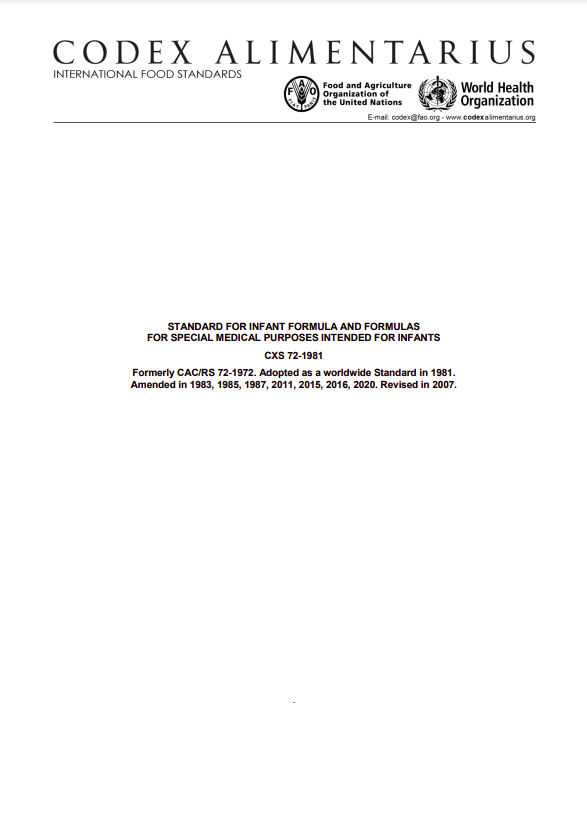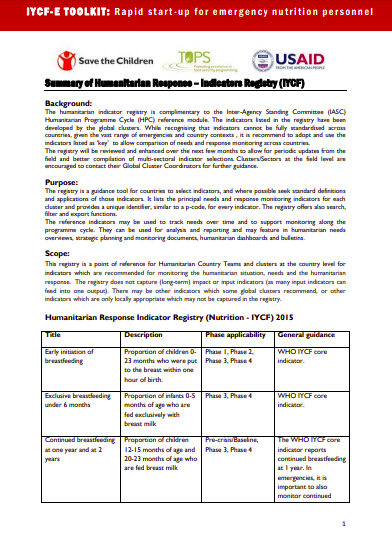Infant and Young Child Feeding in Emergencies (IYCF-E) Toolkit
Share:
The IYCF-E Toolkit is a collection of ready to use tools and practical resources to assist in the design, implementation and monitoring of IYCF-E programs. The objective of the IYCF-E Toolkit is to support practitioners to begin implementation as soon as possible by eliminating the time spent searching for (or creating) tools and, thereby, facilitating a more timely response to the needs of mothers, infants, children and their families in humanitarian emergencies.
The IYCF-E Toolkit curates tools created by partners responding to needs around the world. The Toolkit is a “live” resource benefiting from the continuing creation and documentation of best practices in IYCF-E. The Toolkit is structured in nine chapters with each chapter divided into Key Concepts and Tools. The Key Concepts include the essential, must-have information about IYCF-E in order to plan an appropriate and relevant IYCF-E program. This includes summaries and overviews of the key concepts. The Tools include tools, templates and examples to help you practically implement your IYCF-E program. After each section is a note on References, which will connect you to the Infant and Young Child Feeding in Emergencies Hub where you will find relevant resources providing in-depth knowledge and guidance in that chapter’s subject area.
Please note that you can download the Toolkit either in full or by chapter, section, sub-section or tool. You can also navigate the Toolkit by chapter using the Table of Content here or with the scroll bar and navigation buttons at the bottom of the screen.
This latest version of the Toolkit was updated in July 2022. For assistance with the IYCF-E Toolkit or to make suggestions of additional resources to add, please email us.
This IYCF-E Toolkit was developed by Save the Children with the support of practitioner colleagues around the world and partner agencies in the IFE Core Group. The IYCF-E Toolkit made possible by the generous support of the American people through funding by the United States Agency for International Development (USAID). The contents are the responsibility of Save the Children and do not necessarily reflect the views of USAID or the United States Government.
Chapter 1
1. Policy
Photo: Emnet Dereje - Save the Children
Section One: Key Concepts
General Guidance
5 resources
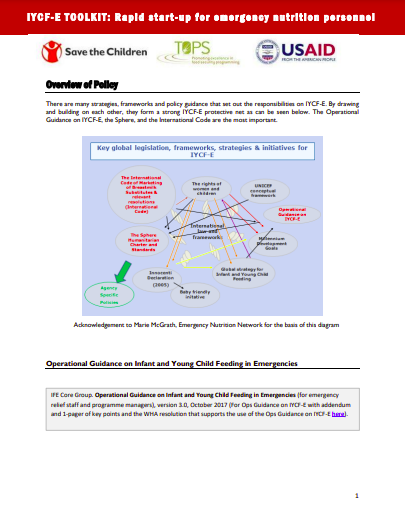
Summary: Overview of Policy
An overview of key global legislation, frameworks, strategies and initiatives for Infant and Young Child Feeding in Emergencies.
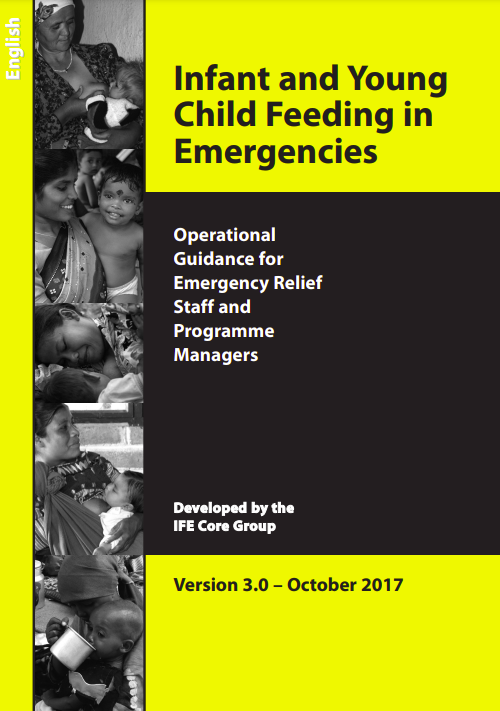
Operational Guidance on Infant and Young Child Feeding in Emergencies (IYCF-E)
Key points from the Operational guidance on Infant and Young Child Feeding in Emergencies (IYCF-E) v2.1, 2007.
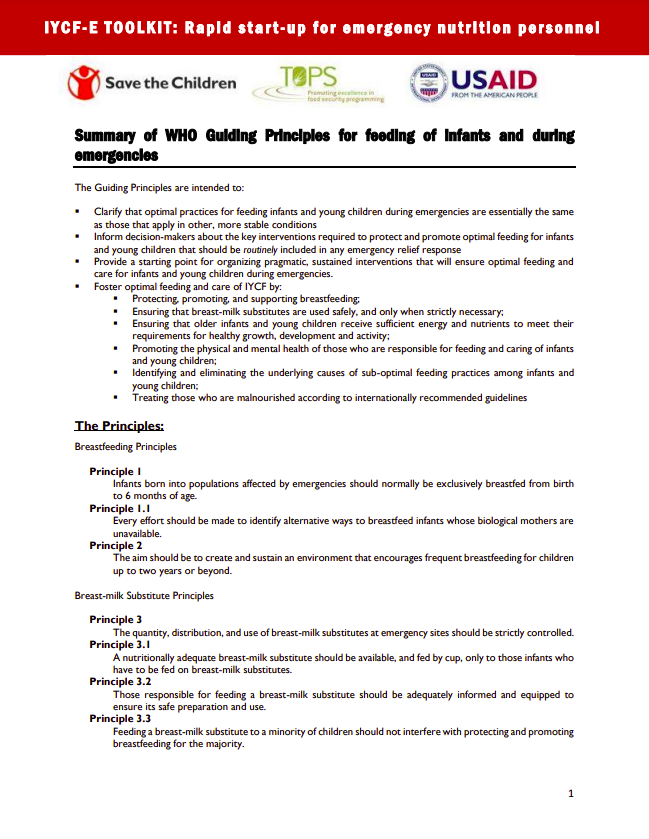
Summary of key guiding principles of WHO for Infant and Young Child Feeding in Emergencies
Summary of key guiding principles of WHO for Infant and Young Child Feeding in Emergencies.
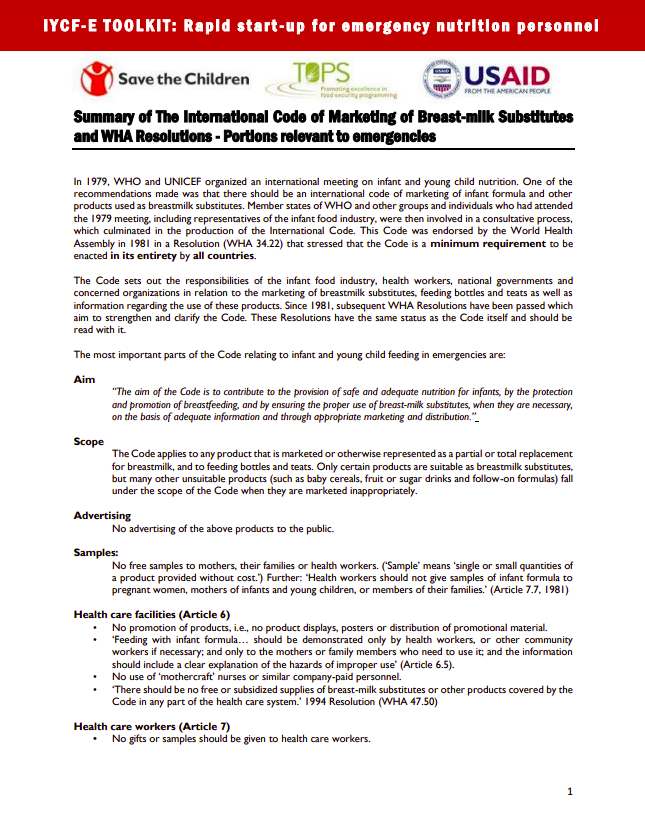
Summary of Key Guiding Principles of the 'International Code of marketing of Breast-milk Substitutes'
Summary of key guiding principles of the 'International Code of marketing of Breast-milk Substitutes' and World Health Assembly Resolutions relevant to Infant and Young Child Feeding in Emergencies.
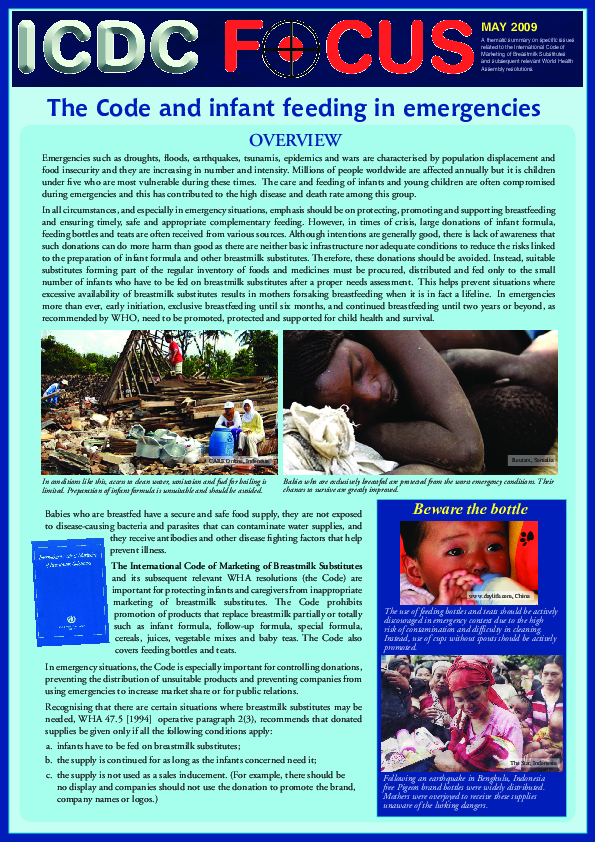
The Code and Infant Feeding in Emergencies ICDC Focus 2009
A technical paper on The Code violations and infant feeding during emergencies, and how to minimise risks to artificial feeding.
Section Two: Tools
Policies
4 resources
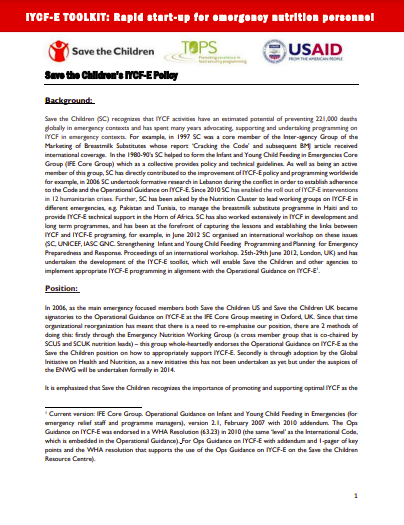
Save the Children's Infant and Young Child Feeding in Emergencies (IYCF-E) Policy
Save the Children's Infant and Young Child Feeding in Emergencies (IYCF-E) Policy.
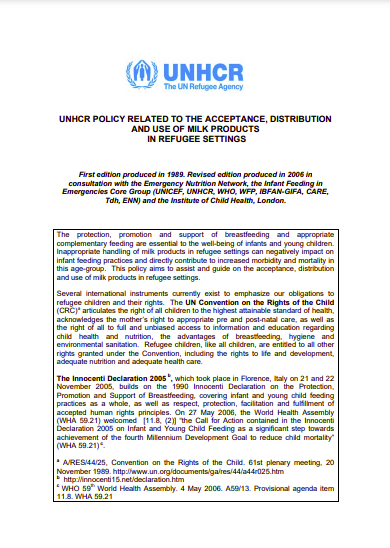
Example of Milk Product Policy UNHCR 2006
UNHCR policy related to the acceptance, distribution and use of milk products in refugee settings.
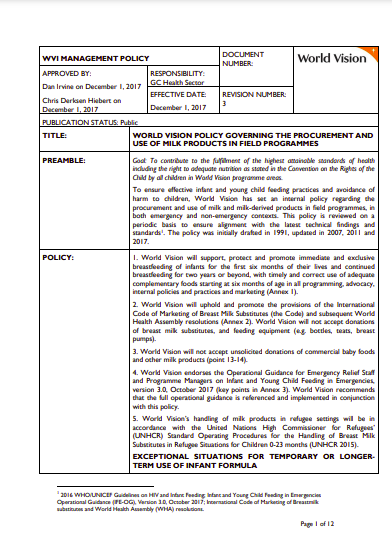
Example of World Vision Milk Product Policy 2017
World Vision’s internal policy on the procurement and use of milk and milk derived products in the field in emergency and on-emergency situations.

Example of Infant and Young Child Feeding in Emergencies (IYCF-E) Position Paper Save the Children 2016
An example of Save the Children’s position on Infant and Young Child Feeding in Emergencies detailing the protection and promotion of breastfeeding, safer artificial feeding, adequate complementary feeding and maternal nutrition, and the minimum actions to be prioritised in Save the Children’s humanitarian programming.
Code
1 resource
General Guidance
4 resources

Country Analysis Exercise: Presentation v1
A sample exercise to map and assess areas of concern for Infant Feeding in Emergencies programming at the country level.
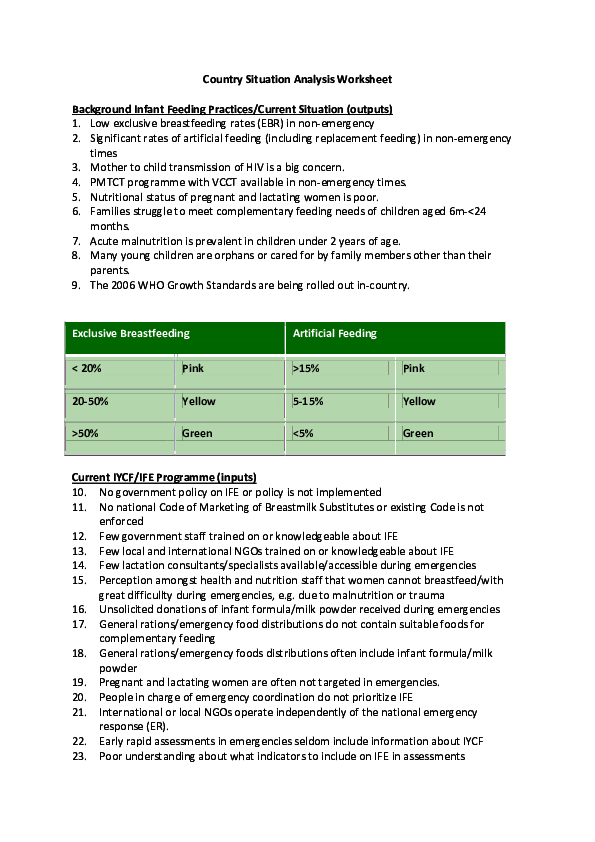
Country Analysis: Worksheet v2
A sample analysis grid from East Africa showing what the exercise would yield.
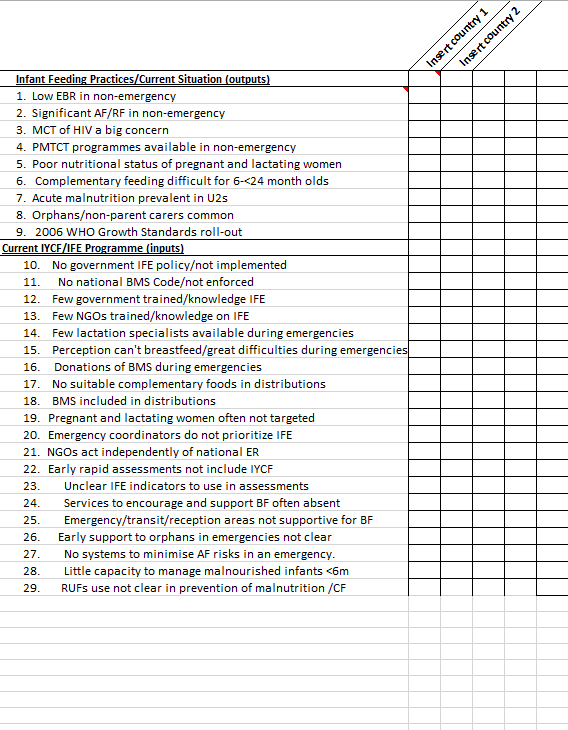
Country Analysis grid East Africa: Template v1
A sample of the analysis grid from East Africa presented in an excel document.
(64.0 KiB)
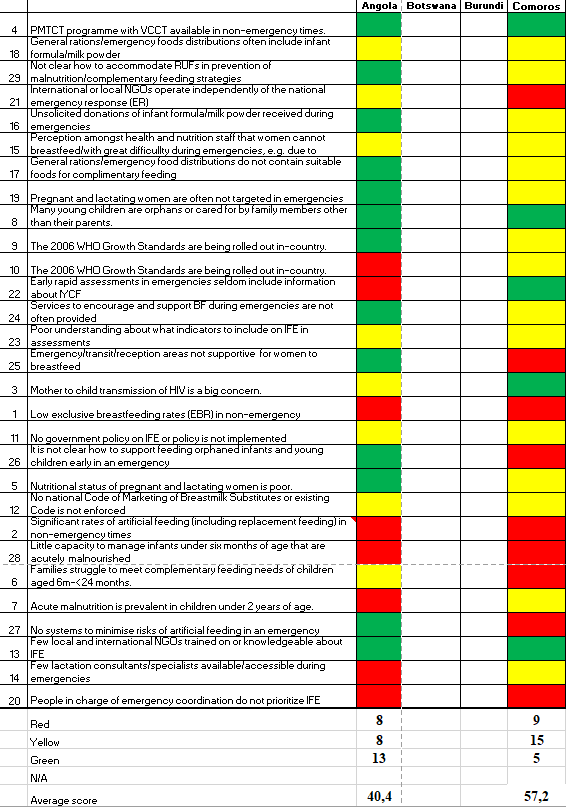
Country Analysis Grid Result Sample: East Africa
Colour coded analysis of East Africa on areas of concern for Infant Feeding in Emergencies programming at country level.
(58.0 KiB)
References
In the Policy Collection on the Infant and Young Child Feeding in Emergencies (IYCF-E) Hub you will find some of the Infant and Young Child Feeding (IYCF) and IYCF-E global guidelines.
Chapter 2
2. Assessing the Need
Photo: LJ Pasion - Save the Children
Section One: Key Concepts
General Guidance
4 resources

Summary: Overview of Assessing The Need
A basic guide for nutrition personnel to determine the need for Infant and Young Child Feeding in Emergencies (IYCF-E) interventions based on what information is available, addressing key questions and identifying useful resources.
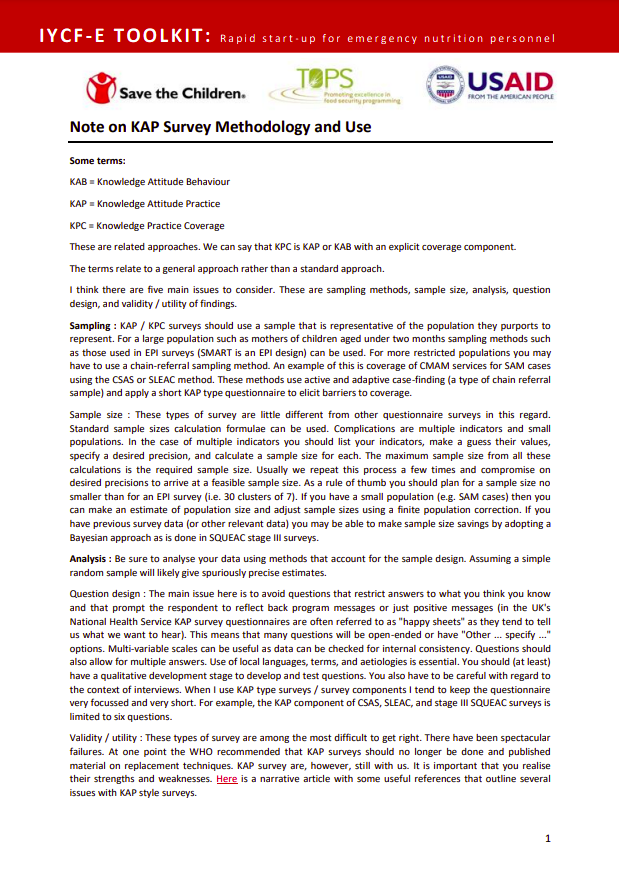
Note on Knowledge Attitude Practice Survey Methodology and Use 2013
A technical review of the significance and relevance of the Knowledge Attitude Practice methodology around five core issues and related recommendations by technical expert Mark Myatt.

Talking About Infant and Young Child Feeding (IYCF) and Child Age: A briefing
A short explanation on how age terms are defined 'technically' and how we understand them in the common language.
Section Two: Tools
Multisector Assessments
7 resources

Example of Multi-sector Top 5 questions: Save the Children
Sector-specific five foremost questions to ask to enable prioritization of a response for Water, Sanitation and Hygiene (WASH), Food Security and Livelihoods (FSL), Nutrition, Shelter, Child protection, Education, Health.
(94.5 KiB)
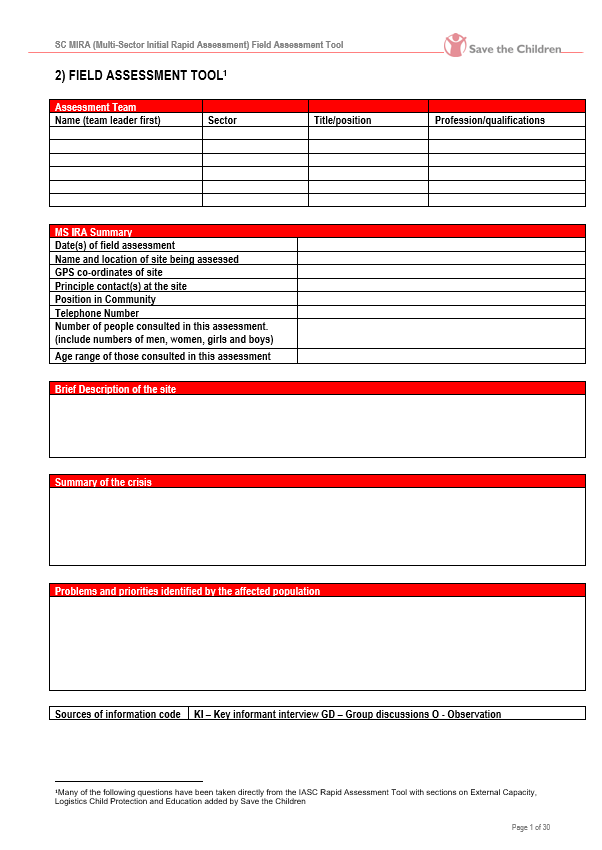
Example of Multi-sector Initial Rapid Assessment Save the Children
A Multi-Sector Initial Rapid Assessment questionnaire based on the top five questions.
(179.5 KiB)
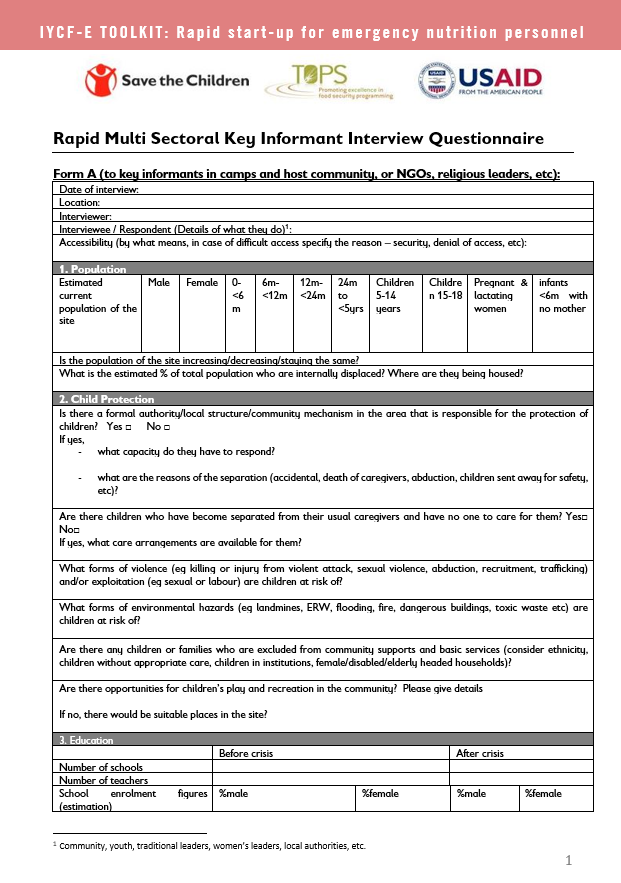
Template for Rapid Multi-sectoral Key Informant Interview Questionnaire
An example of a questionnaire for a multi sector interview of key informants during emergency.
(95.8 KiB)

Example of a Focus Group Discussion Bangladesh 2007
A sample of a format for FGD with caregivers to determine predominant feeding practices and to discover key challenges to their provision.
(54.6 KiB)
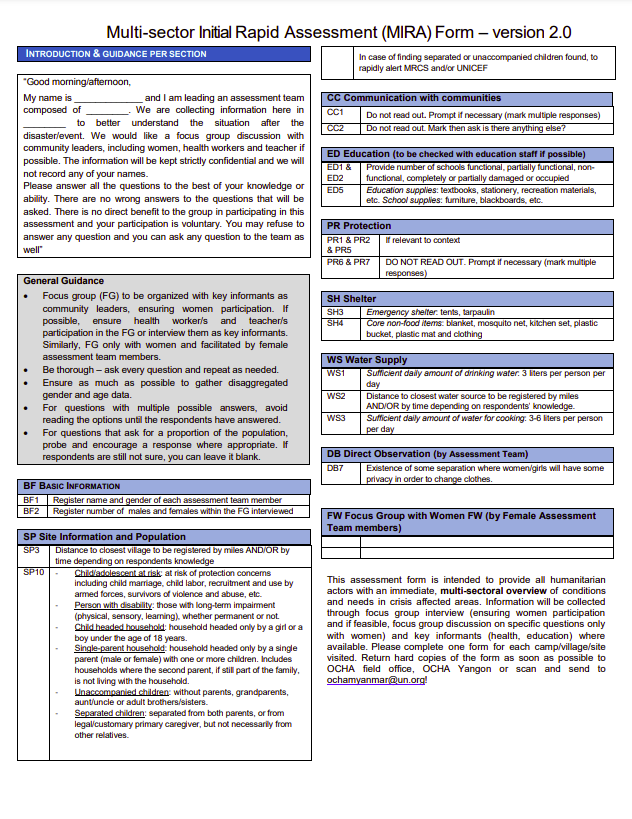
Multi-sector Initial Rapid Assessment (MIRA) template
Multi-sector Initial Rapid Assessment template that includes Infant and Young Child Feeding in Emergencies.

Assessment Toolkit: Save the Children
This document provides two simple tools to assess the situation at the onset of an emergency: initial observation and MS-IRA.
(431.2 KiB)
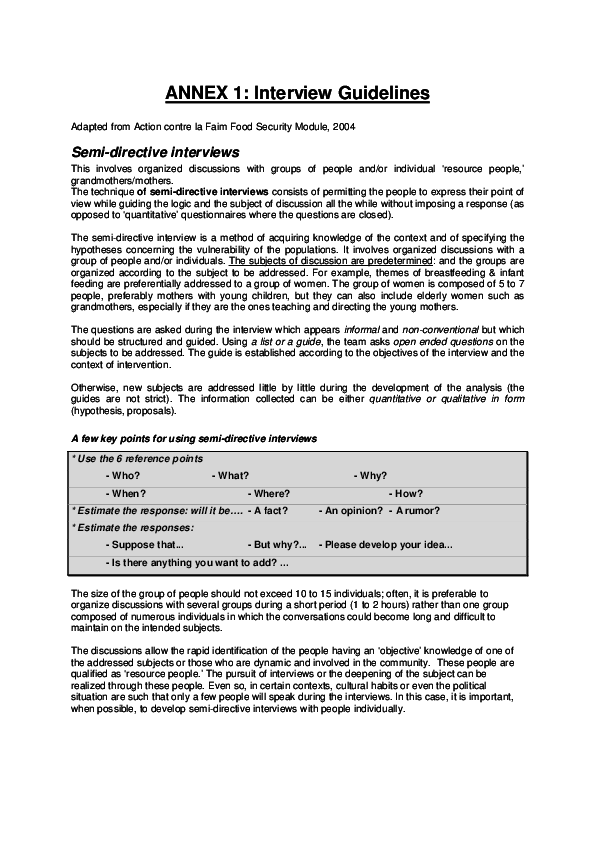
Semi-Directive Interview Guidelines: Action Against Hunger
Action against hunger's (ACF's) introduction to the semi-directive interview methodology and recommendations on a general interview procedure.
Infant and Young Child Feeding in Emergencies Assessments and Surveys
22 resources
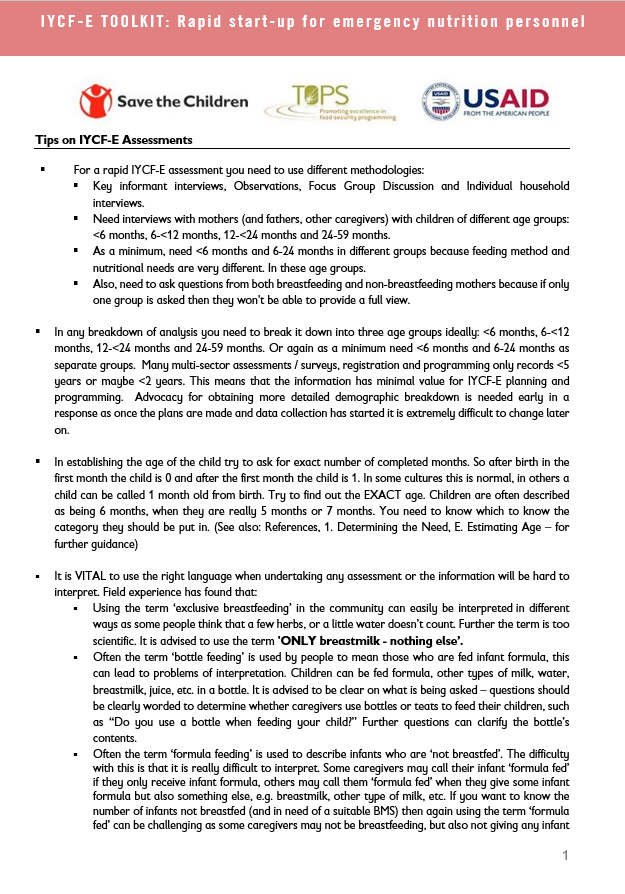
Tips on Infant and Young Child Feeding in Emergencies Assessments & Possible Infant and Young Child Feeding in Emergencies Questions
Basic tips on how to conduct Infant and Young Child Feeding in Emergencies (IYCF-E) assessments and key points to consider while undertaking them, as well as a set of possible IYCF-E initial rapid assessment questions and associated rationale.
(87.7 KiB)

Template for Transect walk
A list of questions based on necessary observations to be made in order to understand what is happening in the community around Infant and Young Child Feeding in Emergencies.
(47.8 KiB)

Example of Village File: Action Against Hunger (ACF) 2004
Action Against Hunger's template which can be used to create a village portfolio ranging from demography to problems identified.

Example of Key Informant Interview: Bangladesh 2007
A sample questionnaire for key informants (health worker or influential community member) used in Bangladesh post cyclone to assess pre and post emergency situation of infant and young child feeding.
(109.5 KiB)
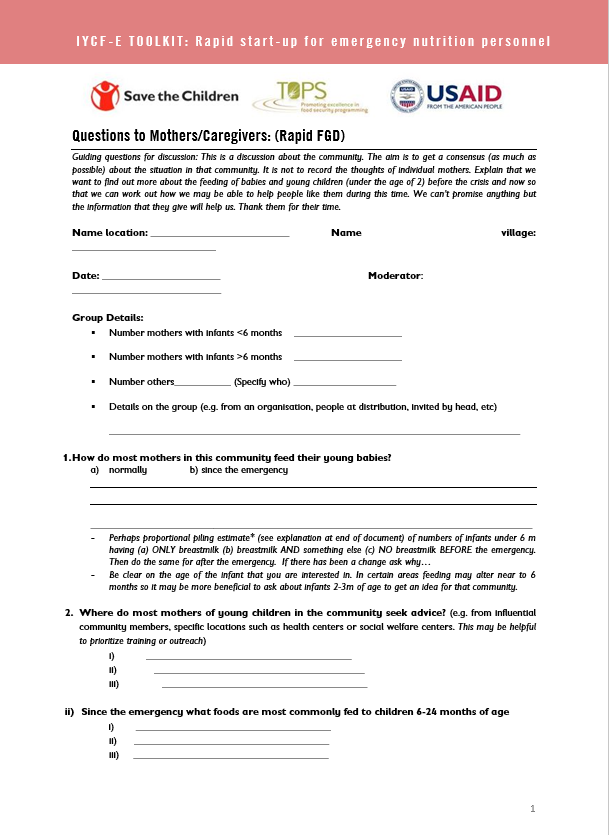
Template for Rapid Infant and Young Child Feeding in Emergencies Focus Discussion Group
A sample of a format for FGD with caregivers to determine predominant feeding practices and to discover key challenges to their provision.
(81.5 KiB)
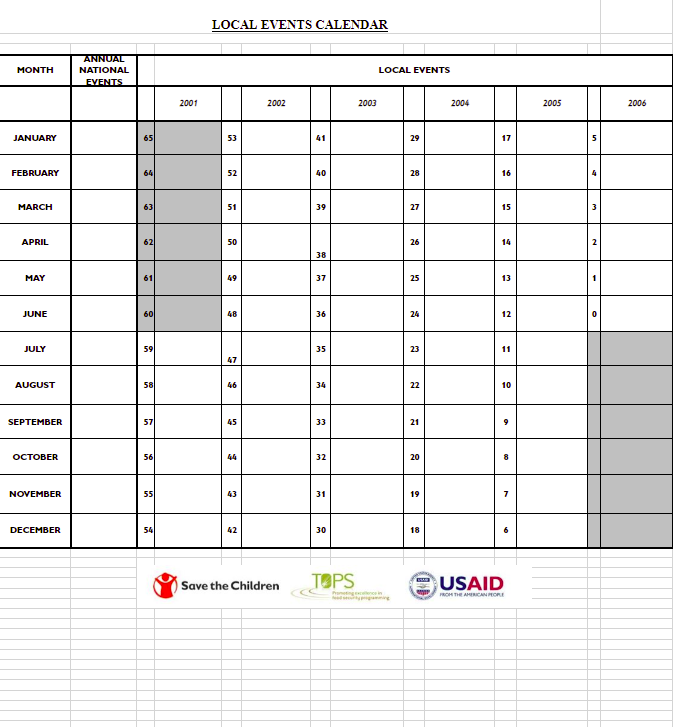
Template for Calendar of Events
Action Agains Hunger's (ACF's) template for a calendar of events that can be used to create a monthly local calendar of events.
(29.0 KiB)
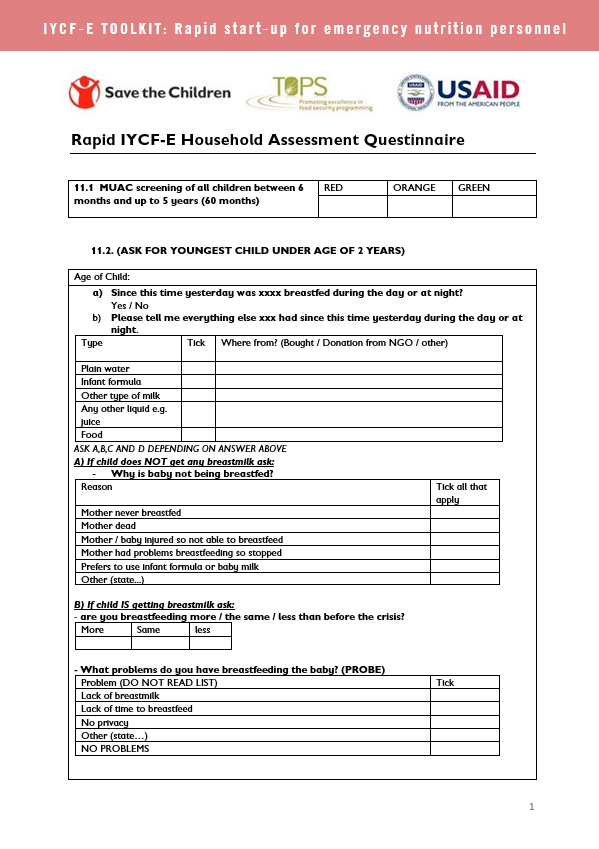
Template for Rapid Infant and Young Child Feeding in Emergencies Household Assessment Questionnaire
A sample household questionnaire for determining gaps in nutrition needs of infants and young children during an emergency.
(126.0 KiB)
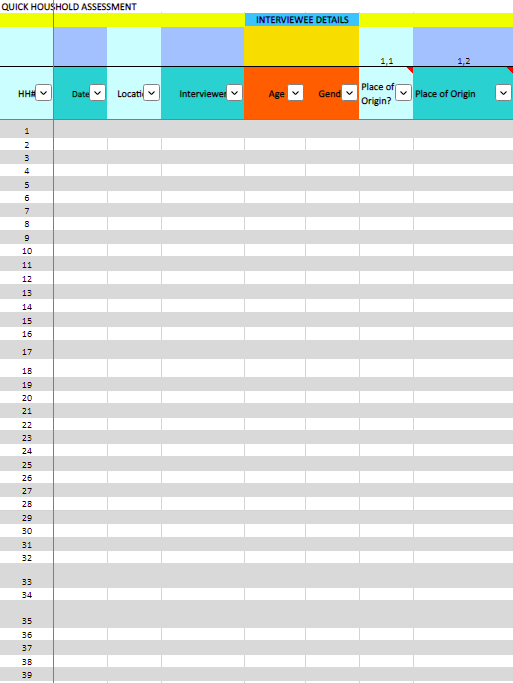
Template for Household questionnaire Results Database
A sample Infant and Young Child Feeding in Emergencies (IYCF-E) database for data entry of the sample IYCF-E household assessment.
(2.0 MiB)

Example of Infant and Young Child Feeding Questionnaire: Indonesia 2006
An example of an Infant and Young Child Feeding questionnaire administered in Indonesia post-earthquake.
(253.5 KiB)

Example of Breastfeeding Group Discussion: Action Against Hunger
Action Against hunger's sample of questions included in the breastfeeding FGD used post-earthquake in Indonesia.
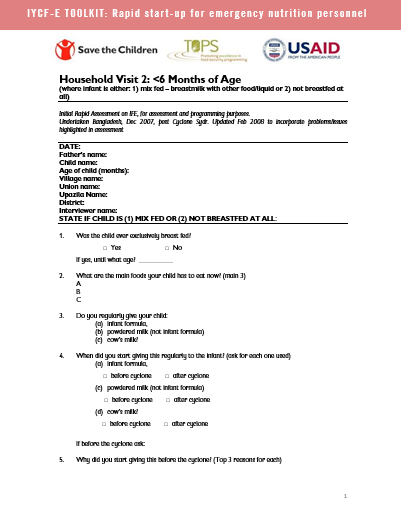
Example of Household Interview Questionnaire: Less than 6 months of Age: Bangladesh 2007
A sample household questionnaire used in Bangladesh post cyclone to assess feeding of non- breastfed or mixed fed infants less than six months.
(130.5 KiB)
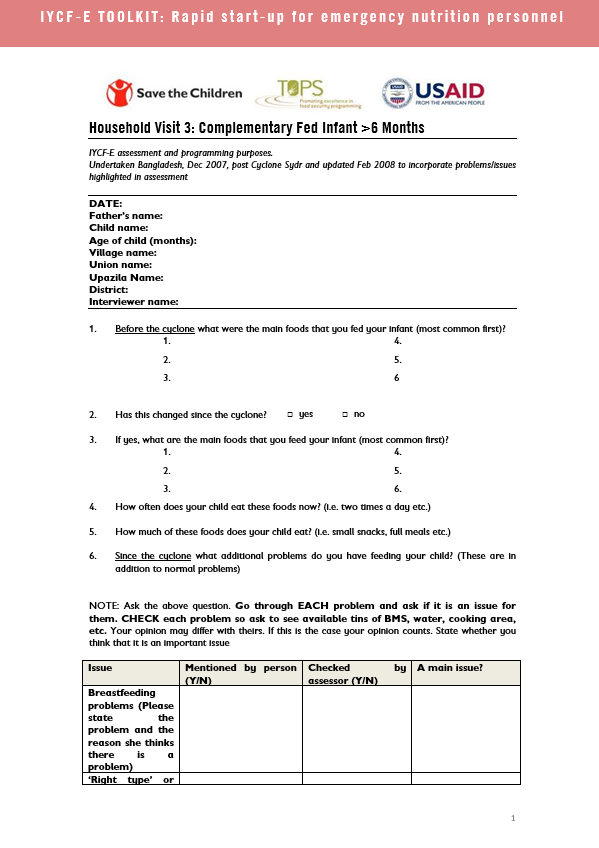
Example of Household Interview Questionnaire: Complementary Fed Infant over 6 months: Bangladesh 2007
A sample household questionnaire used in Bangladesh post cyclone to assess feeding of infants older than six months.
(101.0 KiB)
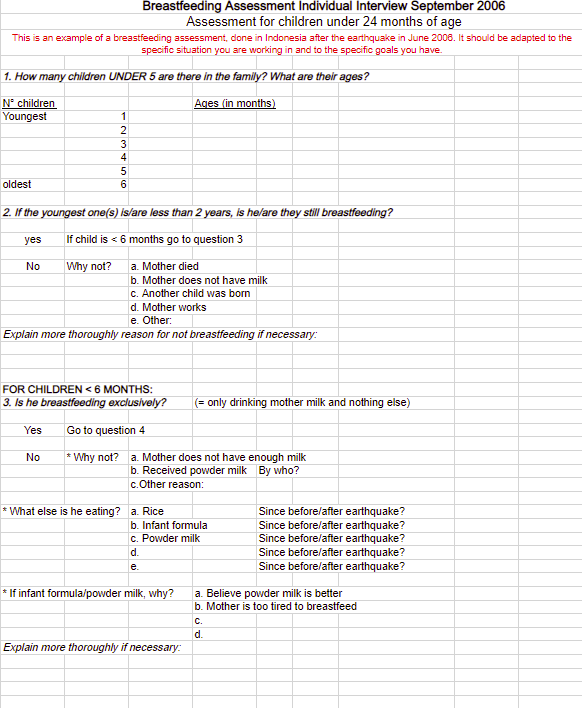
Example of Household Breastfeeding Questionnaire: Action Against Hunger: Indonesia 2006
Action Against Hunger's sample household questionnaire used post-earthquake in Indonesia to assess infant feeding.
(19.6 KiB)
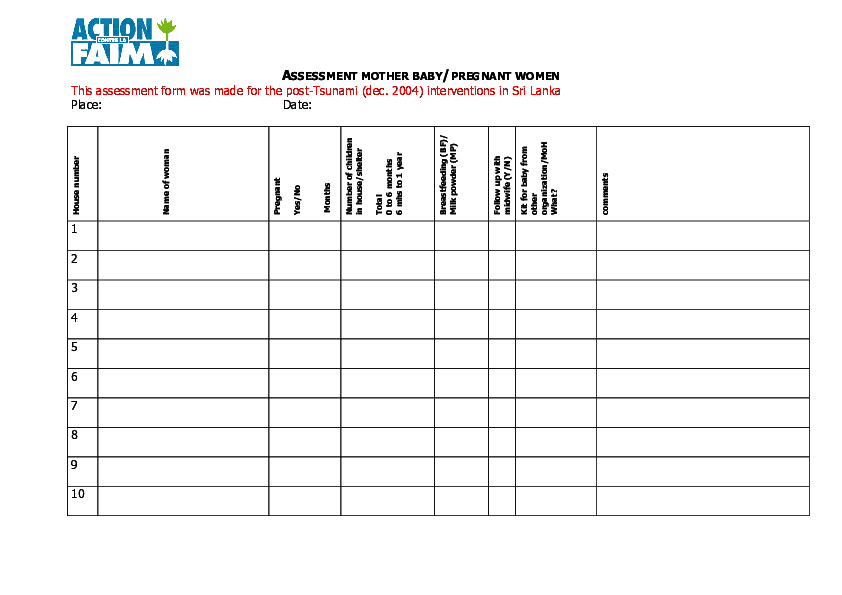
Example of Assessment of Mother Baby Pair: Action Against Hunger 2004
Action Against Hunger's tool to assess resources available to a lactating mother and baby or a pregnant woman.
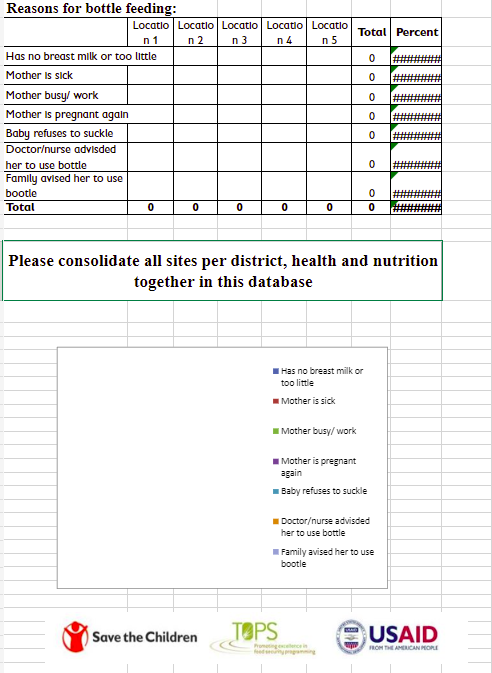
Template for Bottle Feeding Survey Database
A tally sheet for recording usage and reasons for bottle feeding in children 0-24 months according to feed type including analysis.
(60.9 KiB)
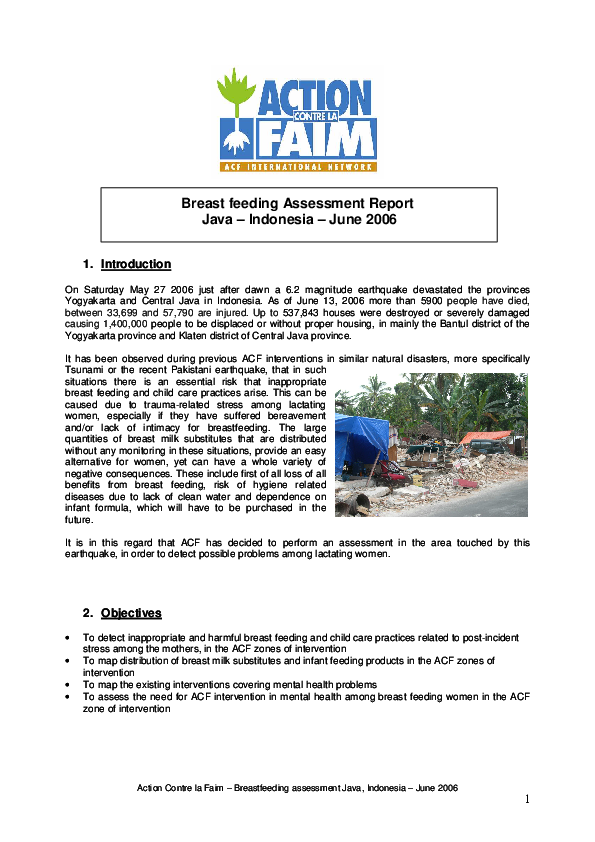
Example of Breastfeeding Assessment Report: Action Against Hunger 2006
Action Against Hunger's introductory guide on when and how to conduct a breastfeeding and infant feeding assessment and how to present and report the results.
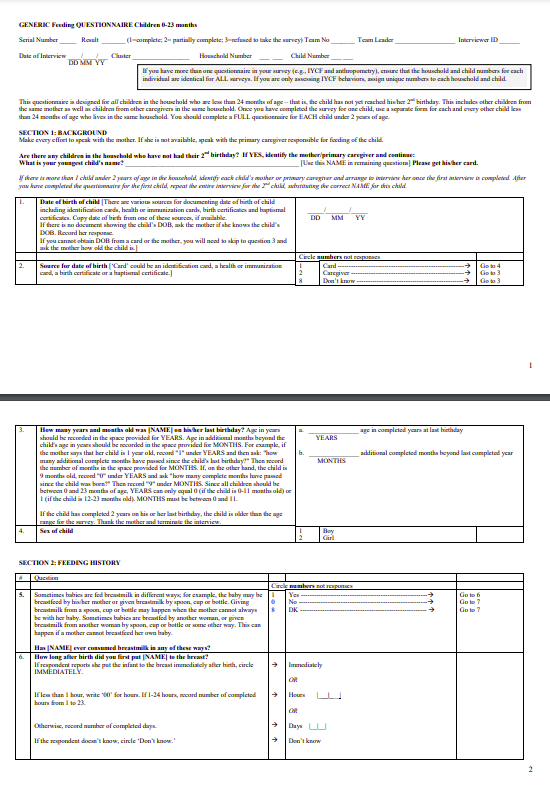
Generic Infant and Young Child Feeding (IYCF) Questionnaire
A generic Infant and Young Child Feeding (IYCF) Questionnaire.

Sample Size
A sample size calculation Tool.
(36.5 KiB)
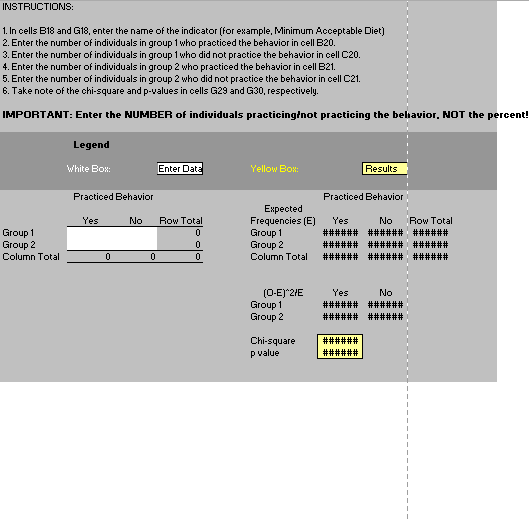
Chi-square Tests
A template for using chi-square test.
(624.0 KiB)
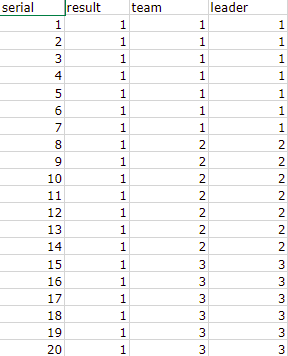
Practice Data File
An excel sheet for practicing data entry.
(45.0 KiB)
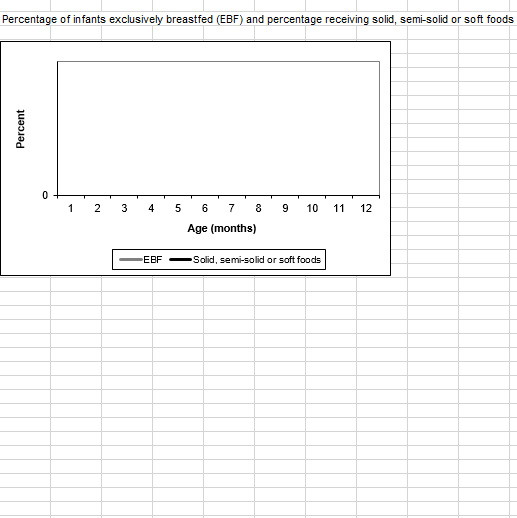
Report Card Template
A template for data consolidation and plotting of graphs on various indicators.
(300.5 KiB)
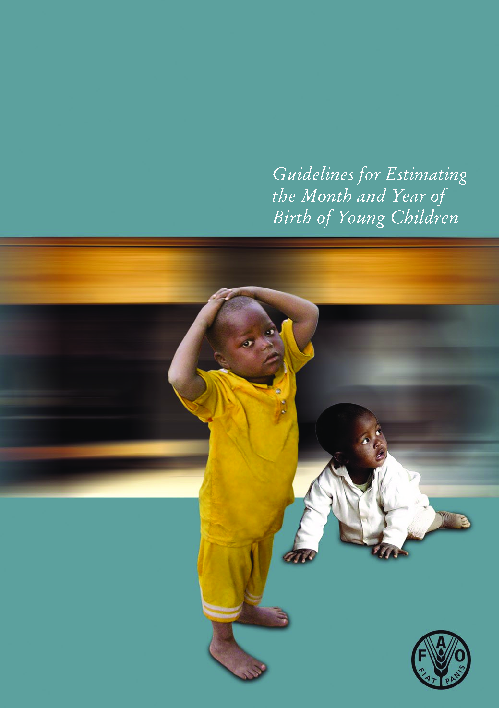
Guidelines for Estimating Age: Food and Agriculture Organization of the United Nations 2008
Guidelines intended for health care workers, survey trainers and others for estimating correct age of a child with a special emphasis on how to create a local calendar of events.
Knowledge, Attitudes, and Practices (KAP) Surveys
11 resources
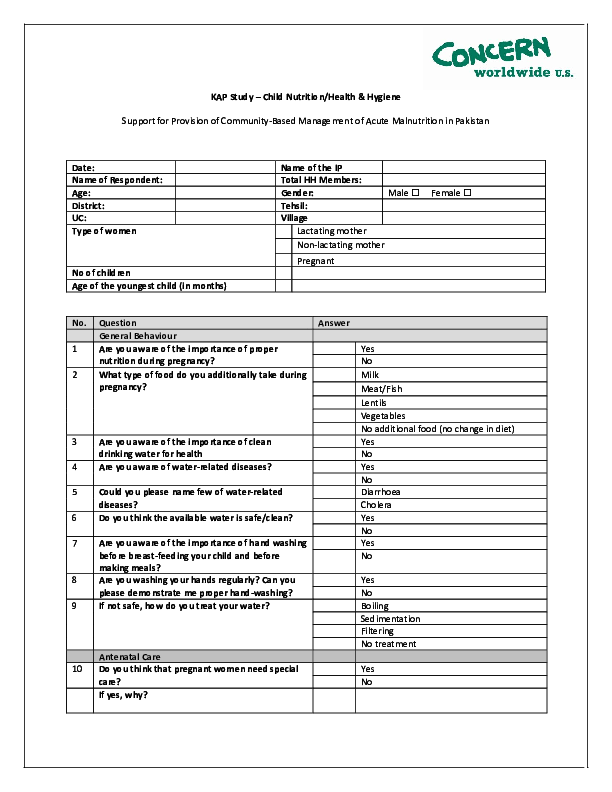
Knowledge, Attitudes, and Practices (KAP) Assessment Questionnaire
Action Against Hunger's (ACF's) sample Knowledge, Attitudes, and Practices (KAP) questionnaire consisting of FSL and nutrition indicators.

Focus Group Discussion Protocols
Action Against Hunger's (ACF’s) brief introduction of what a Focus Group Discussion (FGD) is and how to conduct it.

Focus Group Discussion Questions
Action Against Hunger's (ACF’s) set of sample questions included in an Focus Group Discussion (FGD).

Knowledge, Attitudes, and Practices (KAP) Questions
Action Against Hunger's (ACF’s) set of sample questions included in a Knowledge, Attitudes, and Practices (KAP) survey questionnaire.
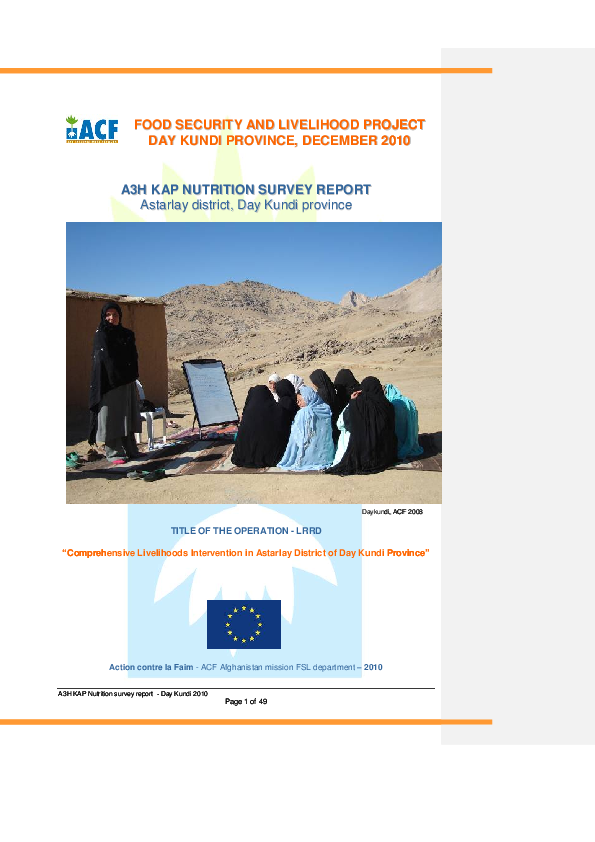
Knowledge, Attitudes, and Practices (KAP) Survey Report
Action Against Hunger's (ACF's) Knowledge, Attitudes, and Practices (KAP) survey report of a project involving integration of nutrition with livelihoods, with the aim being to assess increase in knowledge on nutrition and increased diet diversity.
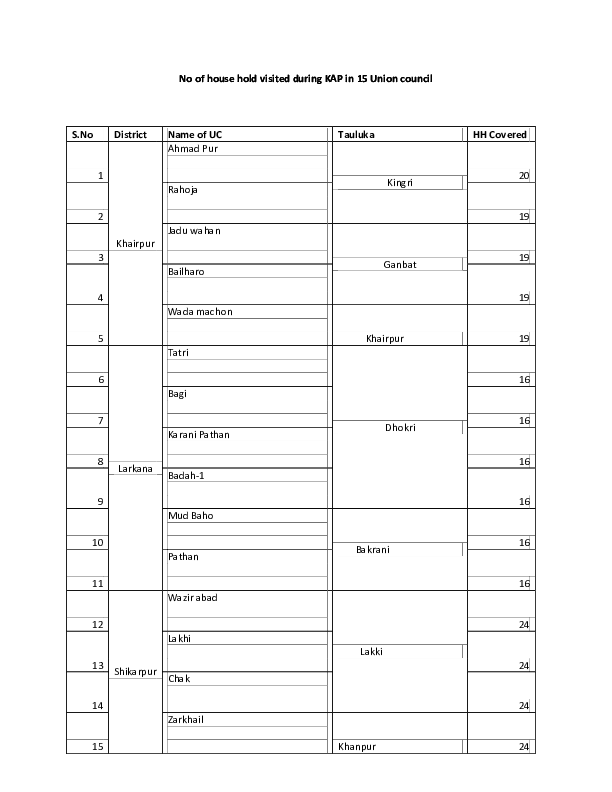
Knowledge, Attitudes, and Practices (KAP) Survey Details
Action Against Hunger's (ACF’s) geographical coverage breakdown to the household (HH) level for a Knowledge, Attitudes, and Practices (KAP) survey for HH questionnaire coverage.
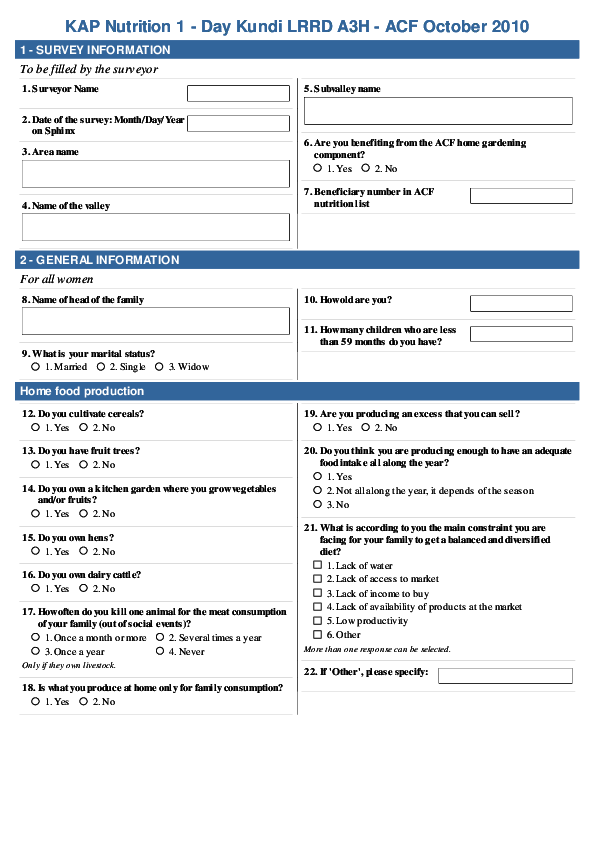
Knowledge, Attitudes, and Practices (KAP) Nutrition Questionnaire
Action Against Hunger's (ACF's) sample Knowledge, Attitudes, and Practices (KAP) questionnaire consisting of FSL and nutrition indicators.
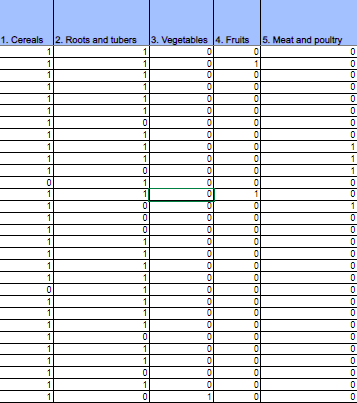
Household Dietary Diversity Score (HDDS) Database
Action Against Hunger's (ACF's) household dietary diversity score (HDDS) database for data entry from the Knowledge, Attitudes, and Practices (KAP) questionnaire
(26.3 KiB)

Knowledge, Attitudes, and Practices (KAP) Questionnaire
Concern Worldwide's set of sample questions included in a Knowledge, Attitudes, and Practices (KAP) survey questionnaire.

Community-based Management of Acute Malnutrition (CMAM) in Pakistan: Working Paper: Knowledge, Attitudes, and Practices (KAP)
Concern's introduction to what the project's Knowledge, Attitudes, and Practices (KAP) survey aims to assess and what methodology will be used.
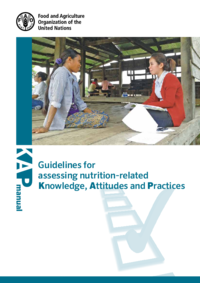
Guidelines for Assessing Nutrition Related Knowledge, Attitudes and Practices: Food and Agriculture Organization of the United Nations 2014
Manual on guidance and practical steps for planning and conducting a KAP survey, and for analysing and reporting the survey findings.
References
In the Assessing the Need Collection on the Infant and Young Child Feeding in Emergencies Hub you will find some reference documents who can guide Infant and Young Child Feeding and Infant and Young Child Feeding in Emergencies related surveys and/or assesments.
Chapter 3
3. Proposal Development
Photo: Jenn Gardella - Save the Children
Section One: Key Concepts
General Guidance
2 resources

Overview of Proposal Development
A summarized collection of resources on Infant and Young Child Feeding in Emergencies proposal development, monitoring and reporting.
(73.0 KiB)
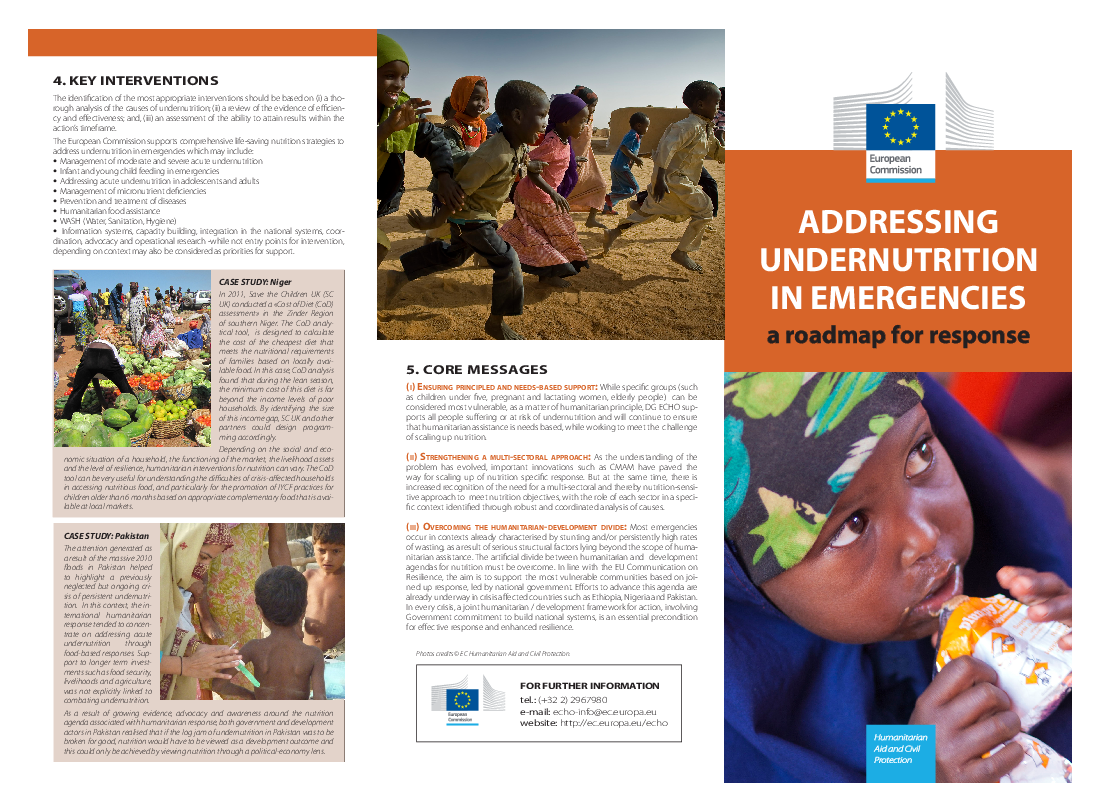
Addressing Undernutrition in Emergencies: Roadmap for Response: European Commission
Summary of key chapters on European Commission's response to undernutrition during emergencies.
Section Two: Tools
General Guidance
5 resources

Example of Infant and Young Child Feeding in Emergencies (IYCF-E) Log Frame: Save the Children
A sample log frame suggesting different interventions, activities and indicators to aid rapid proposal development in emergency contexts.
(19.4 KiB)
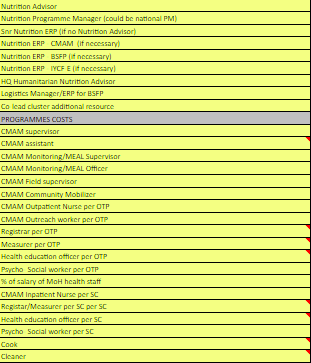
Example of Master Budget Including Infant and Young Child Feeding in Emergencies (IYCF-E) Save the Children
A sample budget of a nutrition project including an Including Infant and Young Child Feeding in Emergencies (IYCF-E) programme encompassing staffing, training, supplies, logistics, survey/evaluation and activity specific costs.
(65.0 KiB)
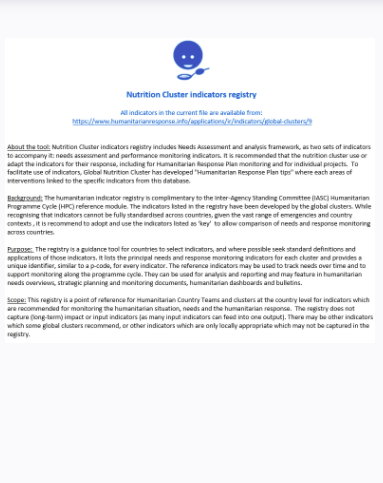
Nutrition Cluster Indicators Registry
2024 · GNC, Global Nutrition Cluster
Nutrition Cluster indicators registry includes Needs Assessment and analysis framework, as two sets of indicators to accompany it: needs assessment and performance monitoring... View Full Abstract
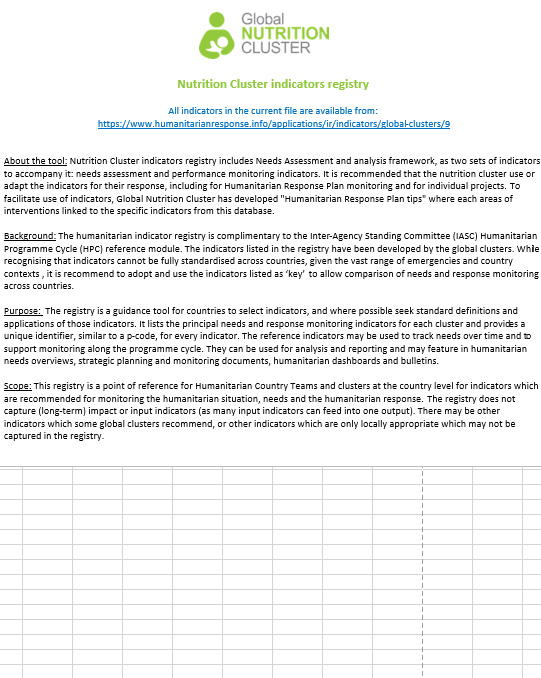
Nutrition Cluster Indicators Registry and Framework
The Nutrition Cluster Indicators Registry and Framework is a guidance tool for countries to select indicators, and where possible seek standard definitions and applications of those indicators.
(301.0 KiB)
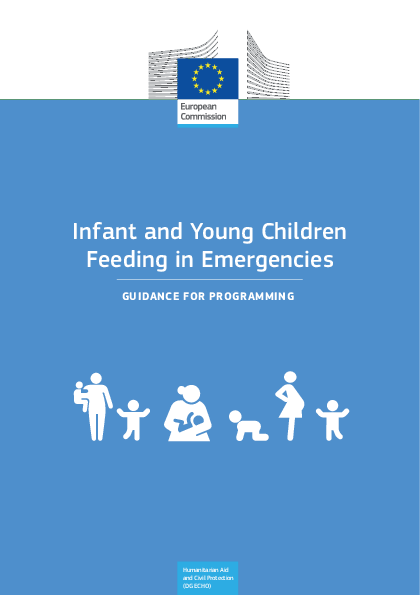
Infant and Young Child Feeding in Emergencies (IYCF-E) Guidance for Programming: European Commission
This document offers a guidance to general practitioners on how to ensure that the specific needs of the infants and young children are assessed and addressed adequately into programming.
References
In the Proposal Development Collection on the Infant and Young Child Feeding in Emergencies (IYCF-E) Hub you will find further resources to support your work.
Chapter 4
4. Program Plan and Reporting
Part 6: Program Plan and Reporting: Tools
All tools
3 resources
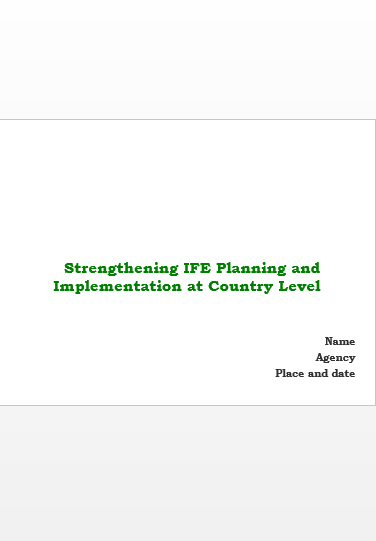
Country Action Plan Guidance: Presentation
Guidance on developing country level action plans to strengthen Infant Feeding in Emergencies planning and implementation.
(659.5 KiB)
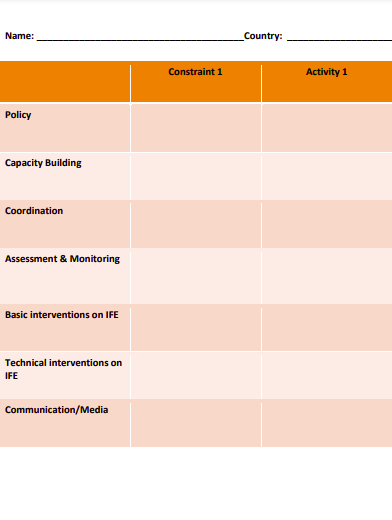
Country Action Plan: Worksheet
A worksheet to record different constraints to Infant Feeding in Emergencies encountered in different fields.
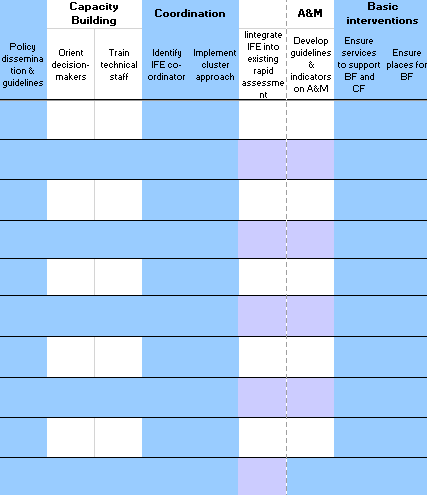
Country Action Plan: Spreadsheet Sample
A template of country-wise working of Infant Feeding in Emergencies in relation to different areas of action.
(45.0 KiB)
Part 5: Tools: Reporting Templates
All tools
26 resources

Template for Simple Rapid Assessment v1
A template for rapid assessment form for a mother-baby pair to identify admissions and further need for full assessment.
(43.3 KiB)

Template for Simple Rapid Assessment v2
A second version of a simple rapid assessment form for a mother-baby pair to identify admissions and further need for full assessment.
(55.6 KiB)

Template for Simple Rapid Assessment: Save the Children Jordan
A template for a simple rapid assessment for a mother-child pair in english and arabic.
(28.1 KiB)

Template for Simple Rapid Assessment Database
Template for a database for a simple rapid assessment.
(88.5 KiB)

Template for Full Assessment Mother-Baby Pair with Breastmilk Substitute
Template for an assessment form of a mother-child pair to identify problems with feeding for a child being given Breastmilk substitute.
(52.0 KiB)

Template for Assessment of Mother-Baby Pair without Breastmilk substitute
Template for an assessment form of a mother-child pair to identify problems with feeding for a child not being given Breastmilk substitute.
(54.9 KiB)

Template for Full Assessment: Save the Children Jordan
Template for full Infant and Young Child Feeding assessment in English and Arabic.
(98.0 KiB)

Template for Infant and Young Child Feeding in Emergencies Beneficiary Card
An example of an Infant and Young Child Feeding in Emergencies beneficiary admission card.
(38.1 KiB)

Template of Assessment Form for Admission of Pregnant women
Template for a questionnaire intended to assess pregnant women for admission to the Infant and Young Child Feeding in Emergencies program and provide possible topics for discussion with the pregnant woman based on the assessment.
(66.5 KiB)

Template for Infant and Young Child Feeding in Emergencies Register Book
Template for a registration book to record admissions and discharges of children 0-23 months and Pregnant and Lactating Women in an Infant and Young Child Feeding in Emergencies program.
(23.7 KiB)

Template of Breastfeed Observation Form
An observation checklist for assessing a breastfeed.
(36.9 KiB)

Template for Summary Sheet for Infant and Young Child Feeding in Emergencies Counseling Sessions in the Field
A sample template for consolidating information from Infant and Young Child Feeding in Emergencies counselling sessions.
(42.6 KiB)

Template for Infant and Young Child Feeding in Emergencies Care Plan for Caregivers Not Using Breastmilk Substitute
A sample template for an Infant and Young Child Feeding in Emergencies care plan for infants not receiving Breastmilk Substitute.
(58.5 KiB)

Template for Infant and Young Child Feeding in Emergencies Care Plan for Caregivers Using Breastmilk Substitute
A sample template for an Infant and Young Child Feeding in Emergencies care plan for infants receiving Breastmilk Substitute.
(73.0 KiB)

Template for Registration Form for Artificially Fed Infants
A template for recording individual consumption of Breastmilk Substitute.
(29.2 KiB)

Template for Breastmilk Substitute Prescription Database
Database for recording admissions and follow-up for beneficiaries using Breastmilk Substitute.
(122.8 KiB)
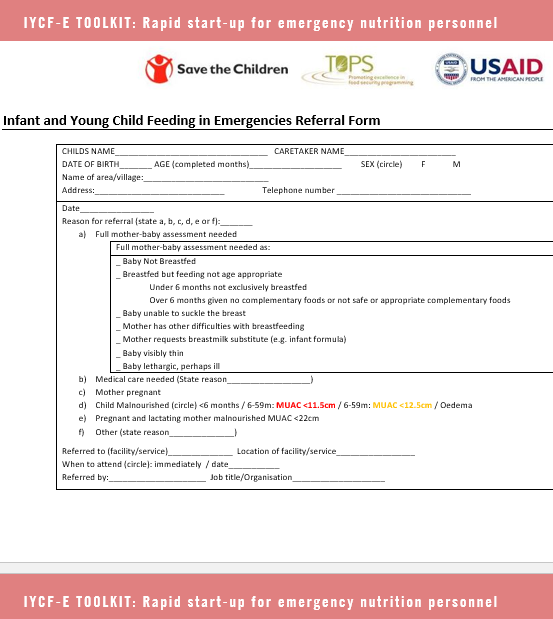
Template for Infant and Young Child Feeding in Emergencies Referral Form
A referral form template for mother-baby pairs requiring further Infant and Young Child Feeding in Emergencies support.
(41.7 KiB)
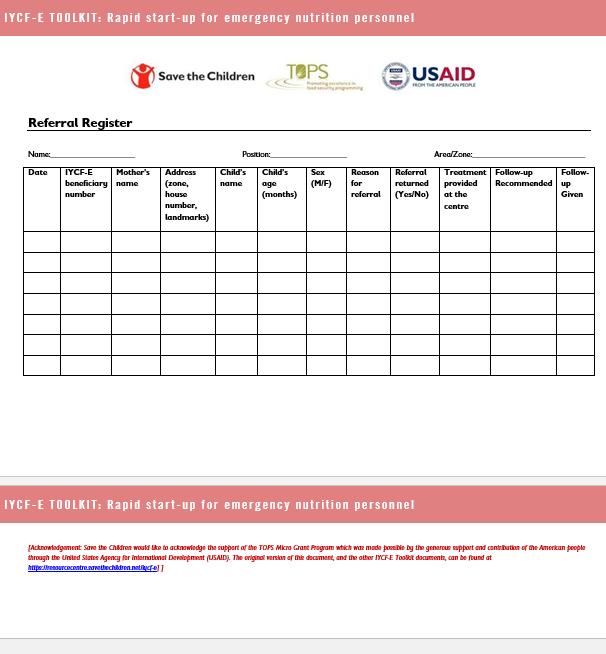
Template for Infant and Young Child Feeding in Emergencies Referral Register
A referral register template for recording mother-baby pairs requiring further Infant and Young Child Feeding in Emergencies support.
(55.5 KiB)
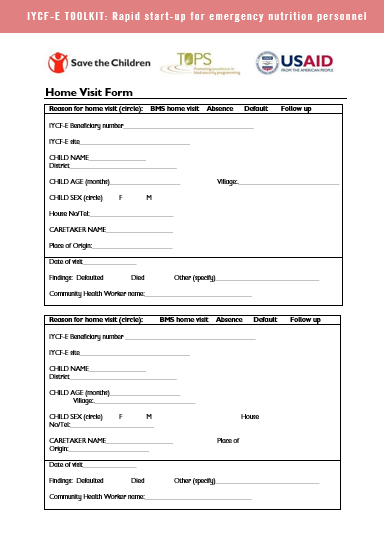
Template for Home visit Form
A form to report on Infant and Young Child Feeding in the home.
(44.7 KiB)
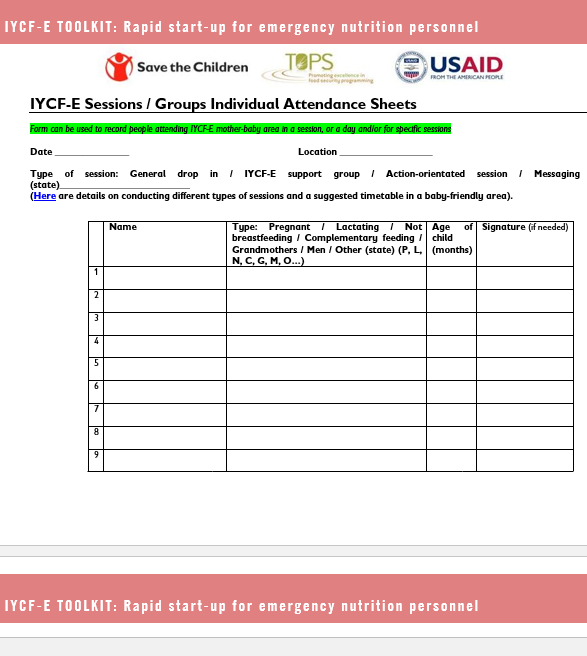
Template for Attendance Sheet for Sessions and Groups
A template for recording individual attendance by target group for Infant and Young Child Feeding in Emergencies sessions and support groups.
(46.9 KiB)
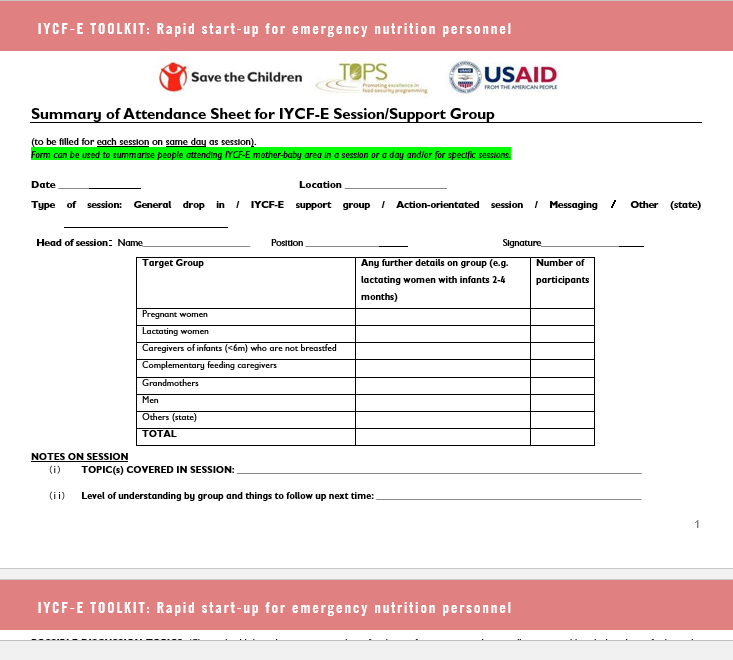
Template for Summary of Attendance for Sessions and Groups
A summary sheet template for consolidating attendance by target group for IYCF-E sessions and support groups.
(50.6 KiB)
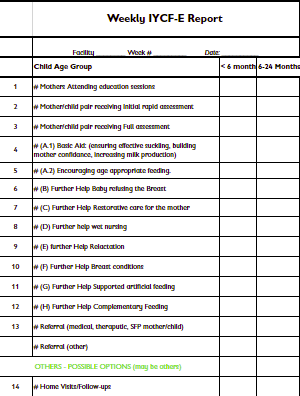
Template for Infant and Young Child Feeding in Emergencies Daily and Weekly Report
An example of a template to consolidate weekly indicators of Infant and Young Child Feeding in Emergencies.
(24.4 KiB)
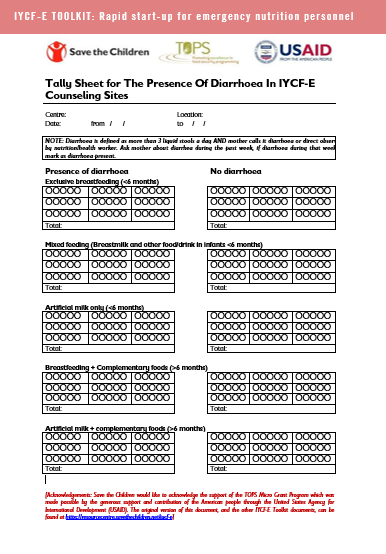
Template for Diarrhoea Tally sheet at Infant and Young Child Feeding in Emergencies centres
Template for a tally sheet to report cases of diarrhoea in Infant and Young Child Feeding in Emergencies sites according to feeding category.
(39.7 KiB)
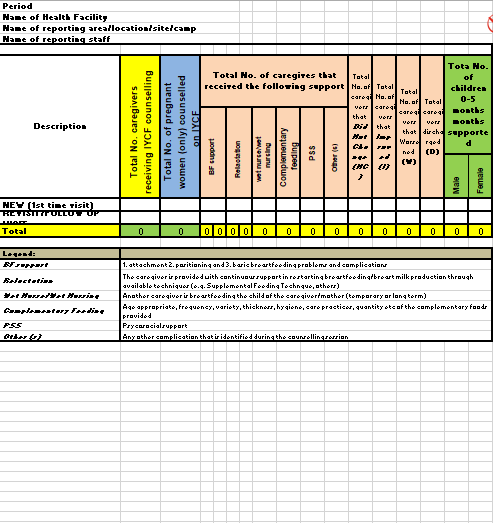
Breastfeeding Guidelines Infant and Young Child Feeding Report
Template for a Infant and Young Child Feeding quantitative report
(76.6 KiB)
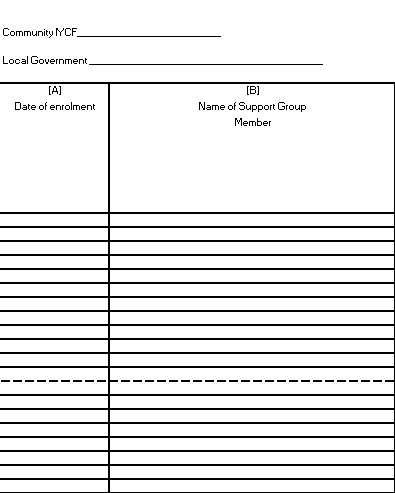
Breastfeeding Guidelines Support Group Register
Template for the registration of attendance to support groups.
(316.6 KiB)
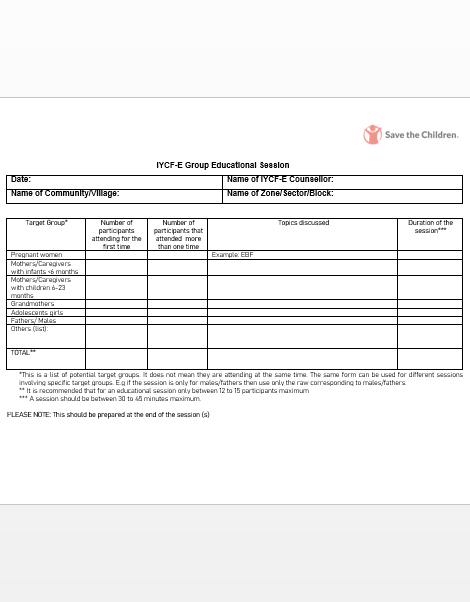
Breastfeeding Guidelines Infant and Young Child Feeding Emergencies Group Educational Session
Template for the report of attendance to support groups.
(43.2 KiB)
Part 4: Tools: Minimising Risk of Artificial Feeding
All tools
20 resources

Example of Breastmilk Substitute Donations Questionnaire: Haiti
A sample questionnaire to record reported Breastmilk Substitute donations.
(42.9 KiB)

Example of Breastmilk Substitute Donations Mapping Report: Haiti 2010
Example of a report on donated Breastmilk Substitute in Haiti, 2010.
(3.5 MiB)

Example of Guide on Minimising the Risk of Artificial Feeding
An example of a guide form Ethiopia to minimise risks of artificil feeding.
(102.0 KiB)
(196.0 KiB)

Template for Reporting Code Violations Quick and Easy Form: IBFAN
Form by IBFAN for reporting code violations.

Template for Monitoring Breastmilk Substitute Violations in Emergency Situations: Global Nutrition Cluster
Breastmilk Substitute violations monitoring form by Global Nutrition Cluster.
(73.5 KiB)

Template for Database for Monitoring Breastmilk Substitute Violations in Emergency Situations: Global Nutrition Cluster
Breastmilk Substitute violations monitoring database by Global Nutrition Cluster.
(21.6 KiB)
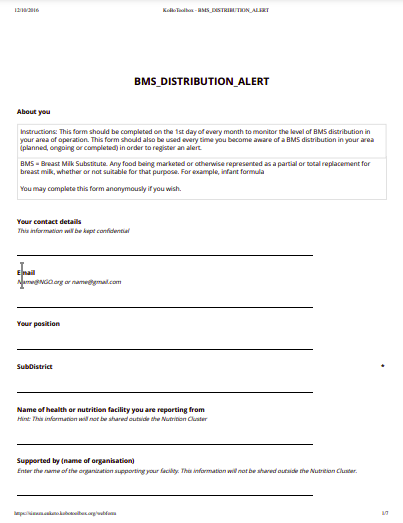
Template for Breastmilk Substitute Distribution Alert KoBo Toolbox Syria
Print version of an online form for reporting Breastmilk Substitute distributions.

Template for Agency Agreement for Breastmilk Substitute with Coordinating Agency
A sample agreement for agencies on Breastmilk Substitute.
(55.0 KiB)
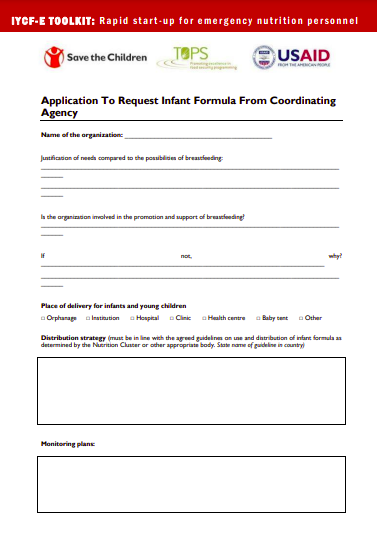
Template for Application for Breastmilk Substitute from Coordinating Agency
A sample application from an agency for distribution of Breastmilk Substitute (BMS) to the BMS coordinating agency.

Template for Evaluation of Artificial Feeding in the Home
An assessment tool used in conjunction with the full assessment of mother-child pair with Breastmilk Substitute to evaluate feeding at home.
(56.2 KiB)

Example of Ready-to-use Infant Formula Exit Strategy: Haiti
A draft of a document used in Haiti outlining when it is appropriate to transition from the use of ready-to-use infant formula (RUIF).
(56.2 KiB)

Example of a Generic Label for Powdered Infant Formula
An example of suitable information for a generic Powdered Infant Formula label.
(1.0 MiB)

Example of a Generic Label for Ready to Use Infant Formula
An example of suitable information for a generic Ready-to-use Infant Formula label.
(69.5 KiB)

Example of How to Sterilize Feeding Equipment: Save the Children: Greece 2016
Instructions on how to sterilize feeding equipment.
(38.3 KiB)

Infant Formula and Diarrhoea
A technical explanation as to why infant formula causes diarrhoea and mortality, particularly in emergencies.
(128.5 KiB)
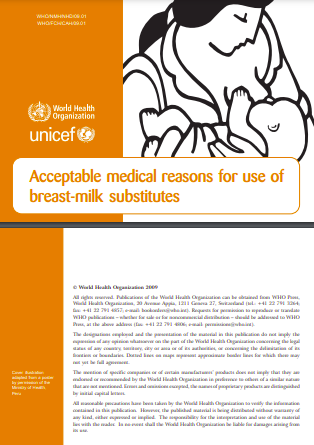
Acceptable medical reasons for breast milk substitutes WHO
Document outlining the acceptable medical reasons for both infants and mothers where use of Breastmilk Substitute is considered acceptable.
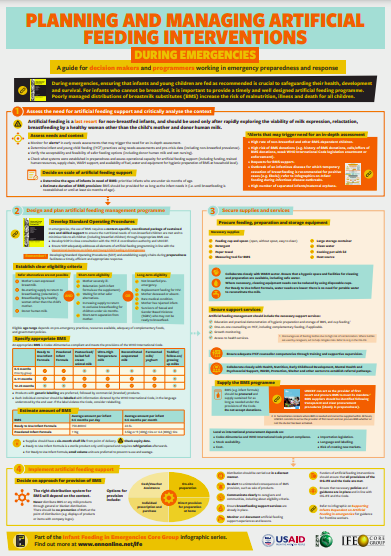
Planning and Managing Artificial Feeding Interventions During Emergencies
An infographic with the key actions for planning and managing artificial feeding interventions.
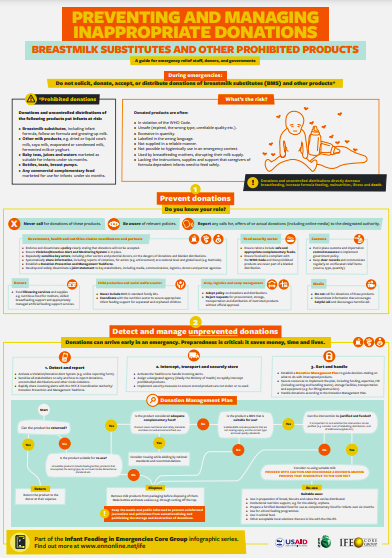
Preventing and Managing Inappropriate Donations of Breastmilk Substitute
An infographic with the key actions to prevente and manage inappropriate donations of Breastmilk Substitute.
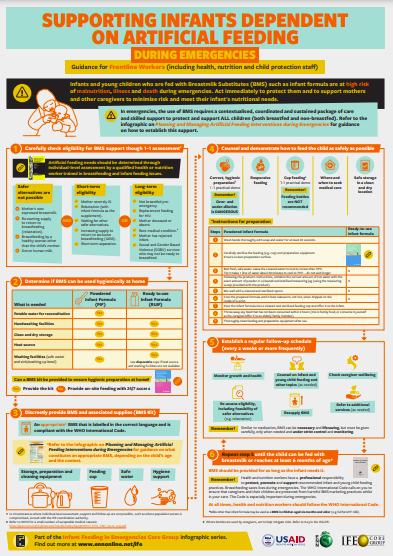
Supporting Infants Dependent on Artificial Feeding During Emergencies
An infographic with the key actions to Support Infants Dependent on Artificial Feeding during emergencies.
Part 3: Tools: Technical Areas
General Guidance
1 resource
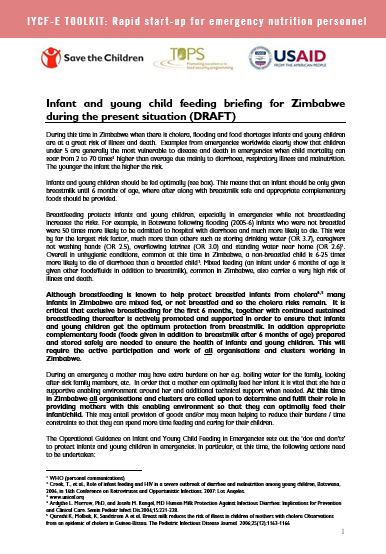
Example of Infant and Young Child Feeding in Emergencies Cholera Briefing
Briefing on Infant and Young Child Feeding during reported cholera in Zimbabwe, which highlights key preventative actions.
(94.0 KiB)
Breastfeeding
5 resources

How to Illustrate Useful tips on Breastfeeding
A list of helpful tips on how to illustrate common breastfeeding concepts during an Infant and young Child Feeding training.
(108.4 KiB)
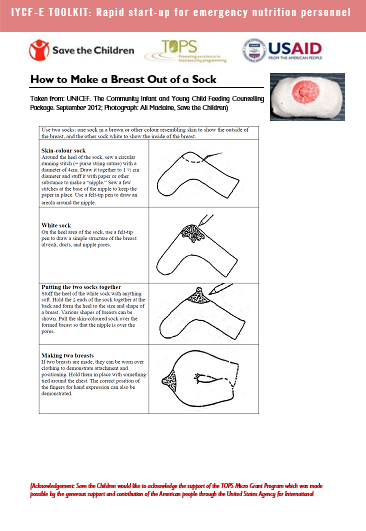
How to make a Breast out of a Sock
An illustration of how to make a breast out of a sock, which can be used as an Infant and Young Child Feeding training aid.
(325.0 KiB)

How to make a Material Baby
An illustration of how to make a material baby, which can be used as an Infant and Young Child Feeding training aid.
(107.5 KiB)

Example of Staff Breastfeeding Guidelines: Save the Children Sierra Leone
A statement on the policy of Save the Children for Sierra Leone staff on breastfeeding.
(50.5 KiB)
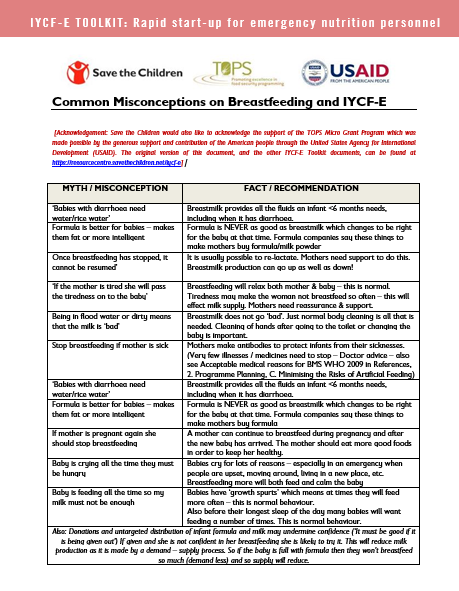
Common Myths on Breastfeeding and Infant and Young Child Feeding in Emergencies
Common myths and misconceptions about Infant Feeding in Emergencies explained by providing facts and recommendations.
(64.5 KiB)
Complementary Feeding
4 resources

Example of How to Wash Blender: Save the Children
Example of Instructions for cleaning blender after food preparation.
(38.3 KiB)
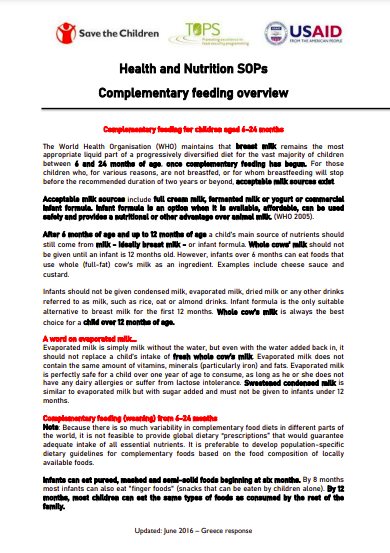
Considerations in Complementary Feeding Save the Children Greece 2016
Important considerations in Complementary Feeding including what, why and how much to give.
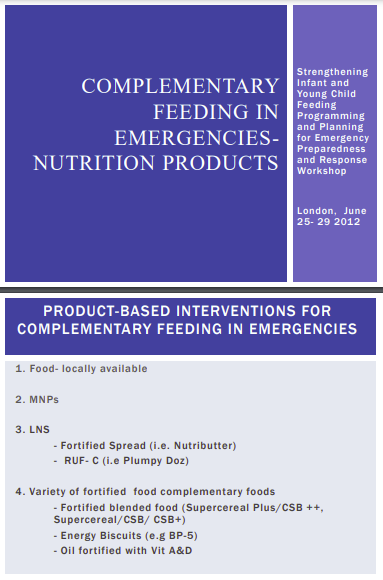
Products for Complementary Feeding in Emergencies
A presentation on the nutritional value of different products that can be used for complementary feeding during emergencies.
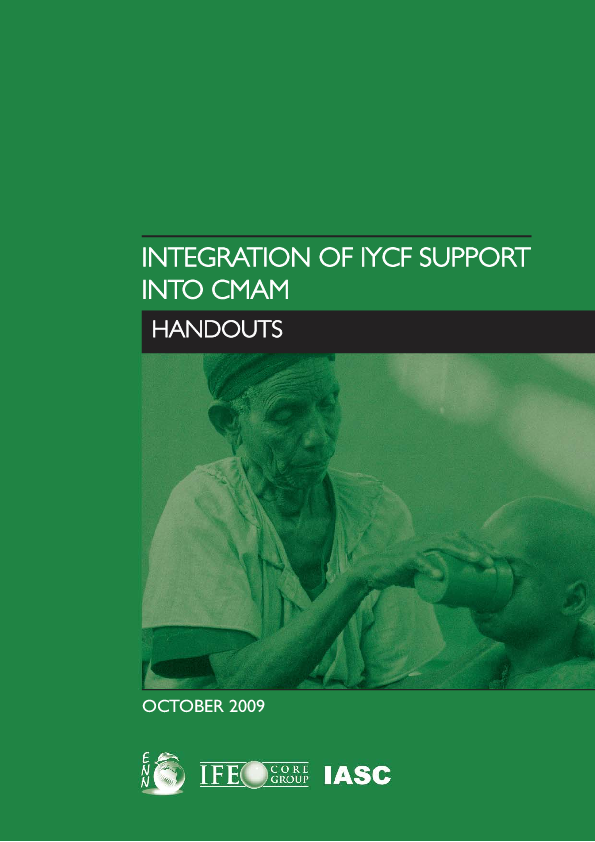
Handouts of the Integration of Infant and Young Child Feeding support into Community-based Management of Acute Malnutrition
An easy reference to information on Infant and Young Child Feeding integration with community-based management of acute malnutrition in the form of hand-outs.
Relactaction
3 resources
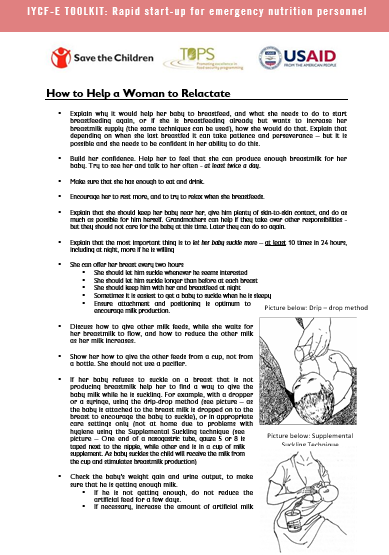
Guidelines to Help Women During Emergencies to Resume or Increase Breastfeeding to Protect and Nourish Their Infant
A document that provide standardised guidelines that will guide field workers in supporting the improvement of breastfeeding practices and the re-establishment of breastfeeding and breastmilk production where this has stopped.
(255.0 KiB)
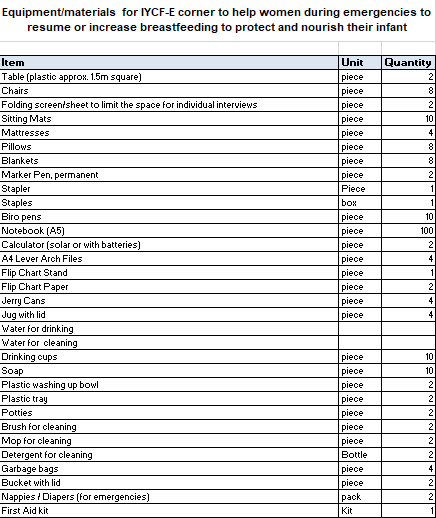
List of Optimized Breastfeeding Protocol Equipment for Infant and Young Child Feedin in Emergencies Area
A list of equipment/materials for Infant and Young Child Feedin in Emergencies corner and to help women during emergencies to resume or increase breastfeeding.
(38.9 KiB)

How to Help a Woman Relactate
A summary of how to help a woman to relactate.
(242.0 KiB)
HIV Wet nursing
1 resource
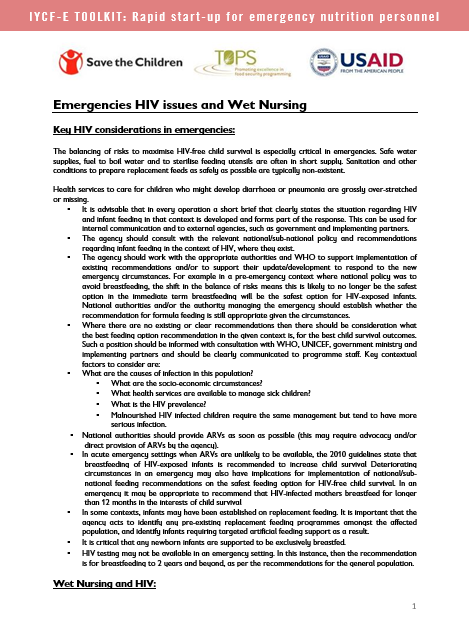
Emergencies HIV issues and Wet nursing
Key considerations for HIV cases and wet nursing during emergencies.
(80.0 KiB)
Management of Acute Malnutrition in Infants (MAMI)
7 resources
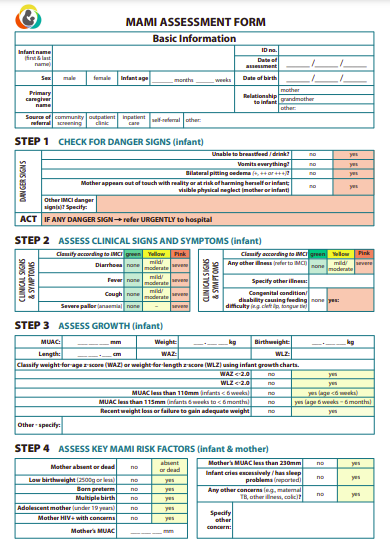
Management of Acute Malnutrition in Infants Assessment Form
Form for the Management of Acute Malnutrition in Infants assessment
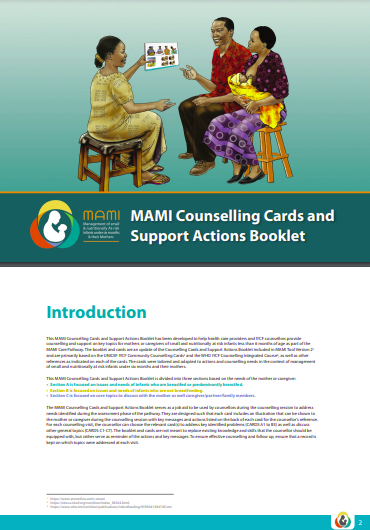
Management of Acute Malnutrition in Infants Counselling Cards
Management of Acute Malnutrition in Infants Counselling Cards and Support Action Booklet

Management of Acute Malnutrition in Infants Enrolment and follow up form
Form for enrolment in Management of Acute Malnutrition in Infants and follow up.
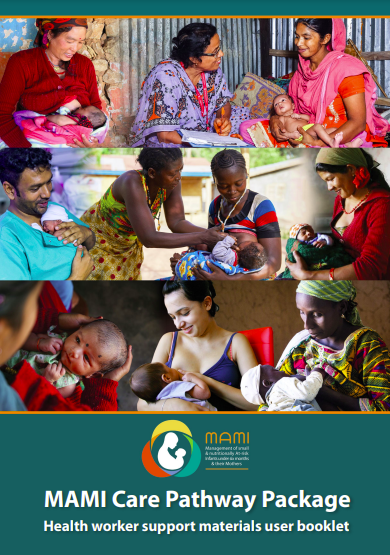
Management of Acute Malnutrition in Infants Healthworkers booklet
Health worker support materials user booklet

Management of Acute Malnutrition in Infants maternal mental health assessment guide
Diagram with the maternal mental health assessment guide

Management of Acute Malnutrition in Infants Maternal Mental Health Assessment Form
Maternal Mental Health Assessment Form
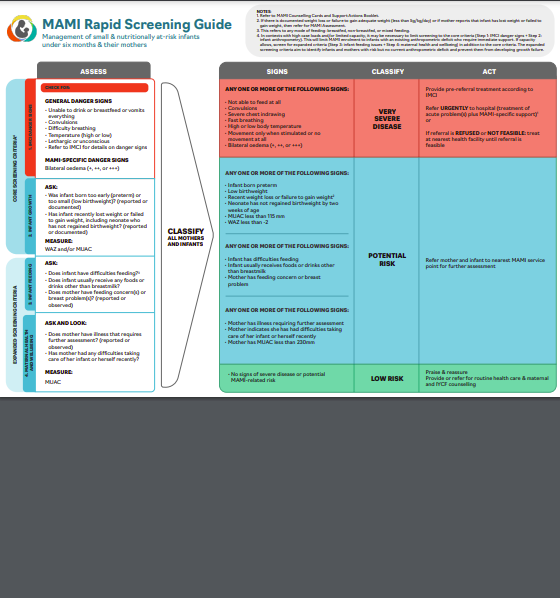
Management of Acute Malnutrition in Infants Rapid Screening Guide
Diagram with the Management of Acute Malnutrition in Infants rapid screening guide
Outbreak Disease and Infant and Young Child Feeding in Emergencies
2 resources
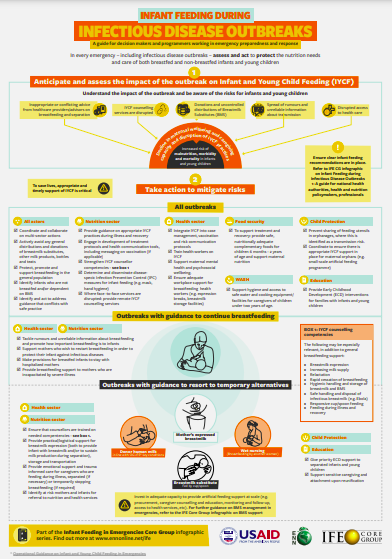
Infant Feeding During Infectious Disease Outbreaks a Guide for Programmers
An infographic with the key points for programmers during infectious disease outbreaks
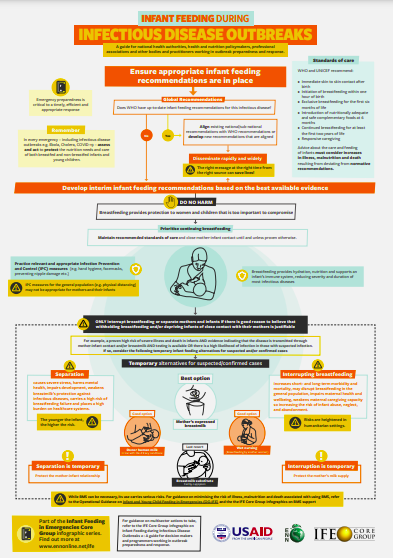
Infant Feeding During Infectious Disease Outbreaks: A guide for policy makers
An infographic with the key points for Infant Feeding policy makers during infectious disease outbreaks
Part 2: Tools: Activities
1 on 1 counsel
3 resources

Template for Spot check Observation List
Template for a spot check assessing hygiene, infant and young child feeding and mother/child interaction.
(36.5 KiB)
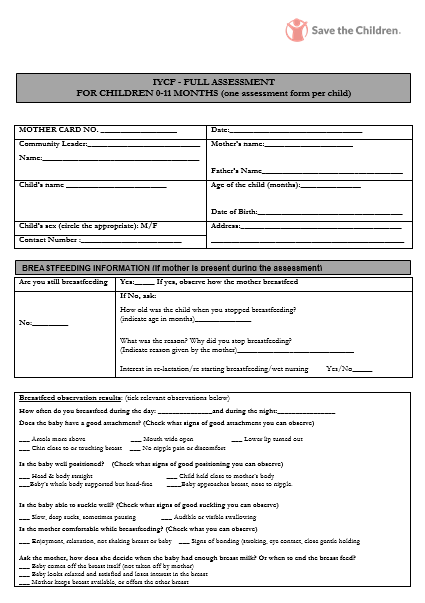
Breastfeeding Guidelines Infant and Young Child Feeding in Emergencies Full Assessment
A form for a full Infant and Young Child Feeding assessment for mothers and babies from 0 to 11 months.
(121.0 KiB)
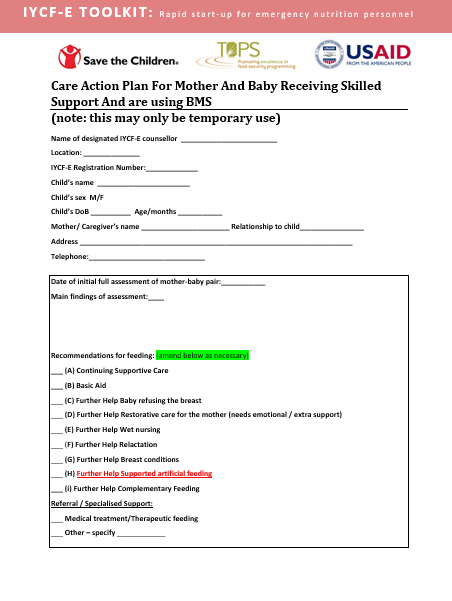
Breastfeeding Guidelines Care Action Plan For Mother And Baby Receiving Skilled Support And are using Breastmilk Substitute
A form for a care action plan for temporary use of Breastmilk Substitute.
(105.0 KiB)
Baby Friendly Spaces
5 resources

Activities Timetable
An example of a daily table of activities for a week in a baby friendly space.
(73.0 KiB)
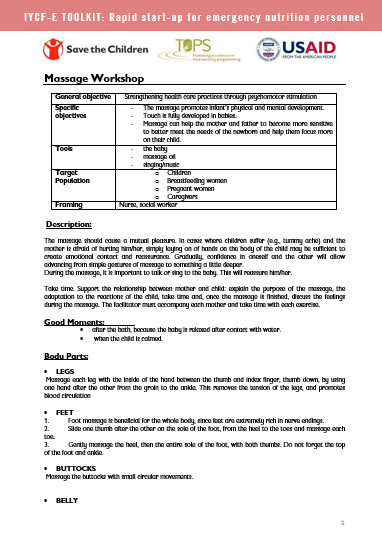
Massage Workshop
A step-by-step guide for mothers on how to massage their baby.
(83.0 KiB)

Example of How to give a Baby massage Save the Children Greece 2016
An example of a baby massage routine used in Greece by Save the Children.
(195.6 KiB)

Example of Data collection methodology for Knowledge indicator Save the Children Greece 2016
An example of the methodology used by Save the Children to assess knowledge retention by mothers.
(39.1 KiB)

Example of How to give Baby a Bath Save the Children Greece 2016
Example of a baby bath routine by Save the Children.
(38.6 KiB)
Cooking Demos
1 resource

Cooking demo Myanmar 2009
Guidelines on how to prepare, plan and carry out a cooking demonstration.
(134.5 KiB)
Support groups
2 resources

How to Conduct an Infant and Young Child Feedin in Emeregencies Support Group
Tips on how to plan and conduct an Infant and Young Child Feedin in Emeregencies support group session.
(52.0 KiB)
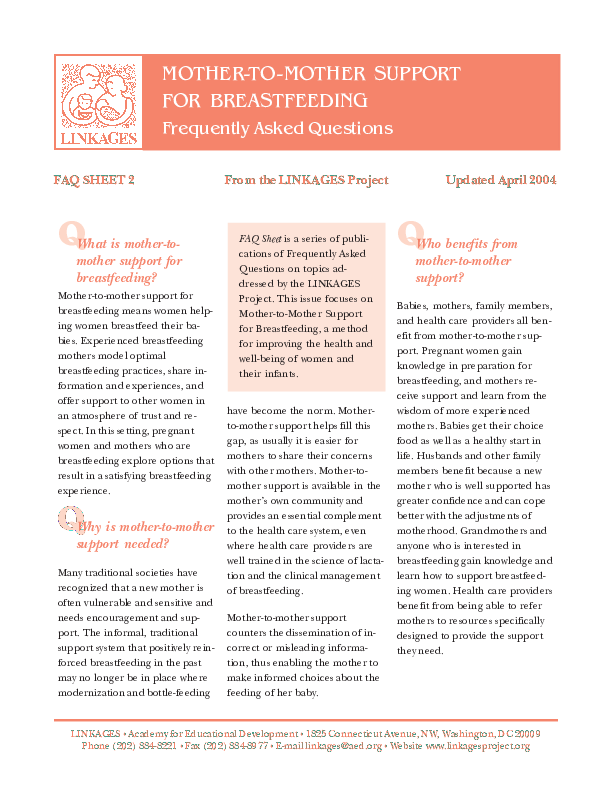
Mother to Mother Support Groups Frequently Asked Questions Linkages
Frequently Asked Questions on Support Groups.
Action Oriented Groups
1 resource

How to Conduct an Action Orientated Group
A guideline on how to conduct an action oriented group activity.
(48.0 KiB)
Mother Baby Area
15 resources

Handwashing Instructions
Instructions on how to wash your hands.
(378.1 KiB)

Technical Guidance for Mother Baby Areas
Guidance on what resources properly outline the international guidance for Mother Baby Areas.
(41.8 KiB)

Input and Equipment for Infant and Young Child Feeding in Emergencies Area
A list of equipment that should be present for an Infant and Young Child Feeding in Emergencies area.
(64.9 KiB)

Checklist
Checklist to supervise Mother-Baby Areas
(44.4 KiB)
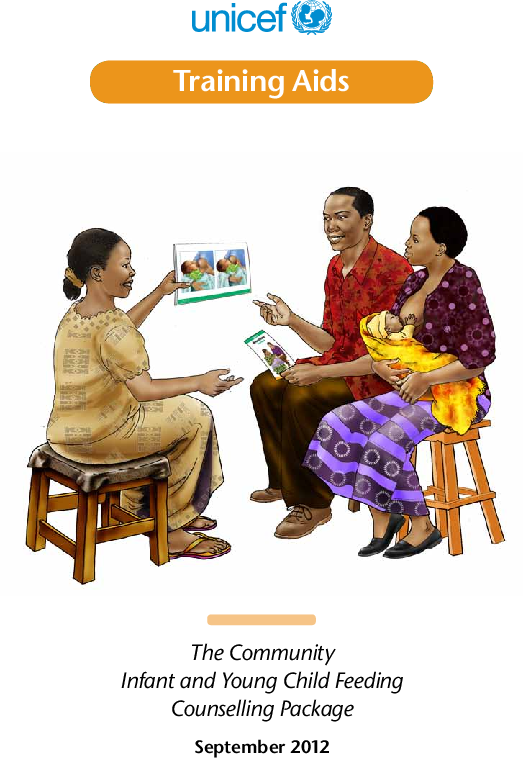
Training Aids of the UNICEF Community
Visuals that complement the training sessions to help participants grasp and retain technical knowledge and concepts.
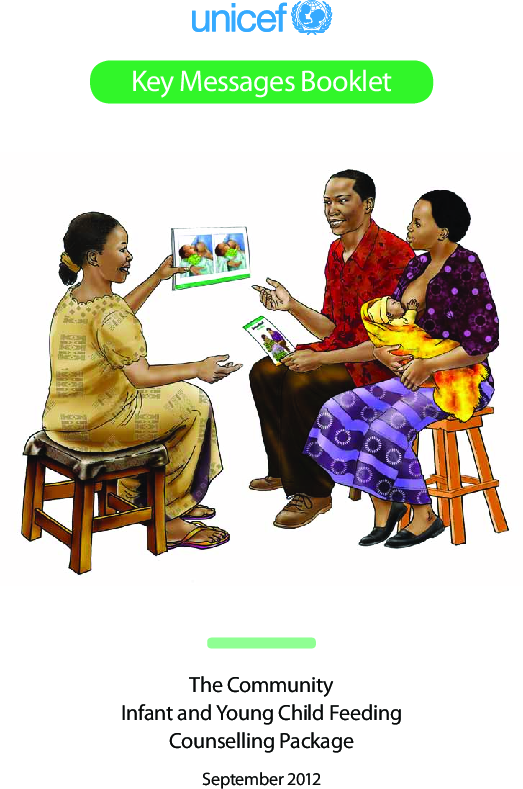
Key Message Booklet for the Couseling Cards of the UNICEF Community
This booklet consists of messages related to each of the IYCF Counselling Cards and copies of the 3 take-home brochures.
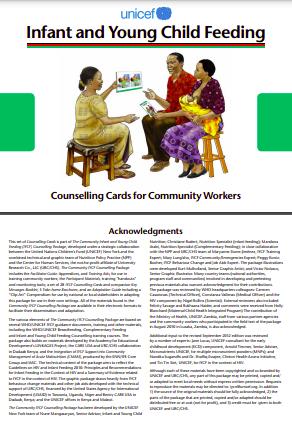
UNICEF Infant and Young Child Feeding Counseling Cards for Community Workers
Counselling cards on breastfeeding under and beyond six months including special conditions such as a sick child and those with HIV.

UNICEF Brochure: How to breastfeed your baby
A two-page brochure explaining how to breastfeed the baby.
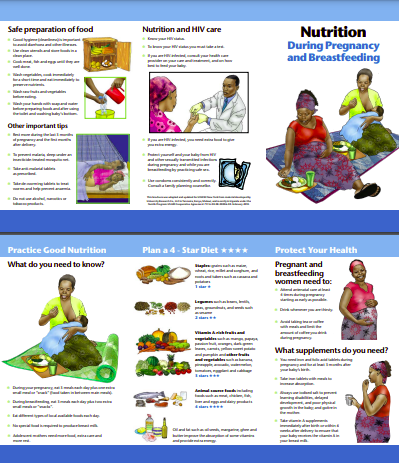
UNICEF Brochure: Maternal nutrition during pregnancy and breastfeeding
A two-page brochure explaining about maternal nutrition during pregnancy and breastfeeding.
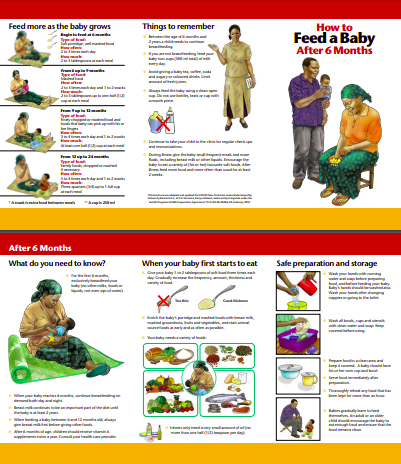
UNICEF Brochure: How to feed a baby after 6 months
A two-page brochure explaining how to feed the baby after 6 months.
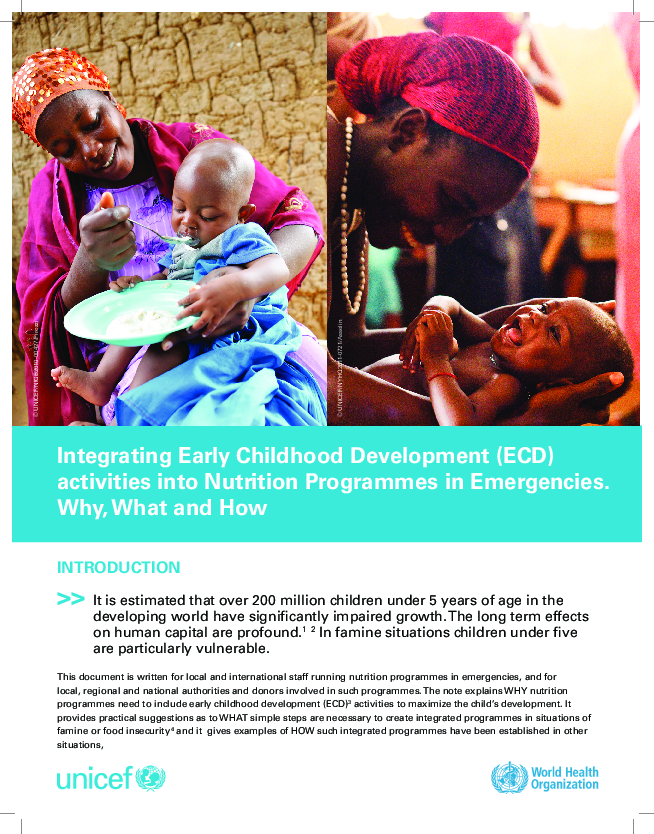
Integrating Early Childhood Development (ECD) into Nutrition Programmes in Emergencies: UNICEF 2012
A technical paper highlighting the significance of integrating Early Childhood Development (ECD) activities within nutrition programmes, providing practical suggestions on what steps to take to achieve that and gives examples of how such integrated programmes have been established in other circumstances.
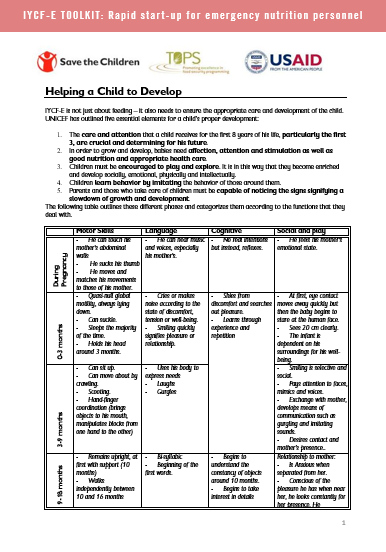
Helping a Child to Develop
Recognizing age specific skills and development stages of a child to fully understand that a healthy child is not just about nutrition but also about development in other areas.
(64.2 KiB)
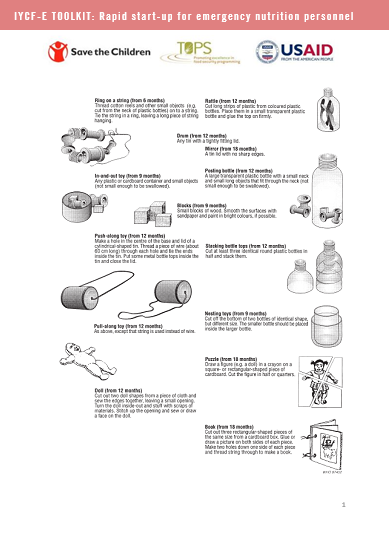
Homemade Toys and Activities
A guide to creating age-specific homemade toys and activities to do with children.
(479.0 KiB)
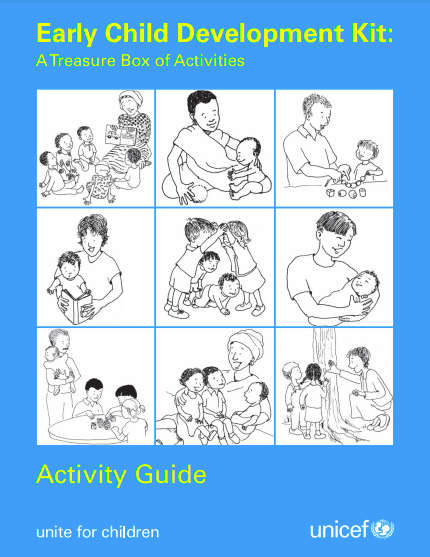
Early Childhood Development Kit Activity Guide UNICEF
A collection of fun learning activities to do with children.
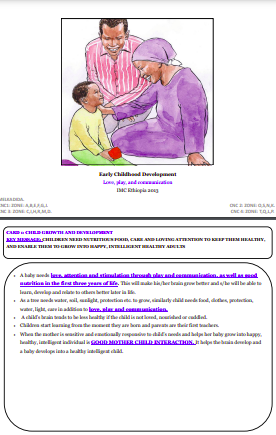
Early Childhood Development cards: Love, play, and communication: IMC Ethiopia
Counseling cards with key messages explained using pictures.
Photo: Hanna Adcock - Save the Children
Part 1: Key Concepts
General Guidance
5 resources

Overview of Programme Planning by Programme Type
Summary of planning Infant and Young Child Feeding in Emergencies programmes based on basic and technical interventions with information on breastfeeding corners, baby friendly spaces, baby tents and care group model.
(206.5 KiB)

Overview of UNICEF, Sphere, Lancet Conceptual Frameworks
Overview of UNICEF, Sphere and Lancet Conceptual Frameworks.
(484.0 KiB)

The Sphere Project 2011: Infant and Young Child Feeding in Emergencies Elements
Infant and Young Child Feeding in Emergencies standards in the SPHERE Project 2011.
(353.0 KiB)

Infant and Young Child Feeding Handshake 2012
Important similarities and differences between Infant and Young Child Feeding and Infant and Young Child Feeding in Emergencies.

Summary of Importance of Psychosocial and Psychological Support
A summary on the importance of psychosocial and psychological support during emergencies using the extended care conceptual framework.
Activities
6 resources

1 on 1 counsel: Overview of Listening and Learning Skills
A list of listening, learning and confidence building skills, the behaviour change model and framework of doable actions.
(86.5 KiB)

1 on 1 counsel: Overview of Skilled Breastfeeding Support Characteristics
An overview of how to provide support through support groups, peer mothers and through one-to- one skilled breastfeeding support.
(107.5 KiB)
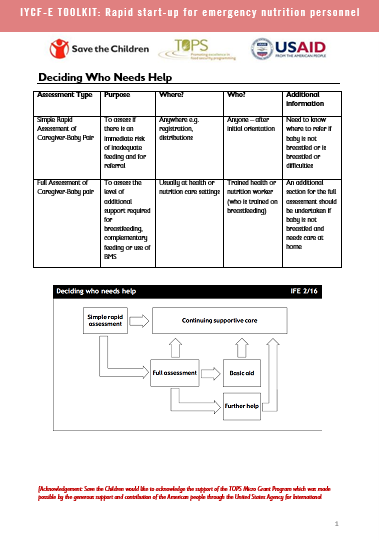
1 on 1 counsel: Deciding Who Needs Help
How to decide whether a simple or a full assessment of mother-baby pair is required.

Support groups: Development of Mother to Mother Support Groups
Presentation with the key points to develop a Mother to Mother Support Group
(67.5 KiB)

Support groups: Summary of Care Groups Core Group
Summary of Care group model about How to set up the care group model and highlight the efficacy of such an intervention.
(295.0 KiB)

Baby Friendly Spaces: Baby Friendly Tents World Vision
A non-technical document providing a description of Baby Friendly Tents and an overview of their general set-up and operation to support infant and young child feeding (IYCF) in emergencies.
Technical Areas
11 resources

Breastfeeding: Overview of Kangaroo Care
An explanation on Kangaroo care including what it is, why it is important and how it can be done.
(297.5 KiB)

Breastfeeding: Infant Feeding in Emergencies Summary Sheet for Training
A summary of information on assessing an appropriate breastfeed and minimizing risks to artificial feeding.

Complementary Feeding: Recommended Complementary Feeding Practices and Counseling
Recommended complementary feeding practices and key discussion points to have with the caregiver.

Complementary Feeding: Summary of Complementary Feeding Guiding Principles for Non-Breastfed
A summary of guiding principles for complementary feeding non-breastfed children 6 to 24 months of age.

Complementary Feeding: Active and Responsive Feeding Tip Sheet
Tips on the importance of responsive feeding and how can this be achieved.
(63.0 KiB)

MAMI: Summary of Managing Acute Malnutrition in Infants
A summary of infant feeding guidelines for infants under six months with reference to material available on MAMI within the toolkit.

MAMI: Summary of MAMI
Summary of MAMI approach updated 2021, includes history, definitions anf general info of the most recent MAMI Care Pathway package

Managing Acute Malnutrition in Infants: Assessment Guide
Diagram with the assessment guide

Summary of Recommendations for HIV in Infant Feeding
Summarized recommended HIV infant feeding and related frequently asked questions.
(151.0 KiB)

Summary of Key Considerations for Maternal Nutrition
Key considerations on effect of maternal nutrition on breastmilk.

Early Initiation of Breastfeeding During Emergencies
An infographic with the key actions to promote, protect and support the early initiation of breastfeeding during emergencies.
Minimising risk of artificial feeding
7 resources

Targeting Criteria for Breastmilk Substitutes
Guideline for targeting breastmilk substitutes appropriately and avoiding wrong admissions for Breastmilk Substitute programmes.
(74.5 KiB)

Ready to Use Infant Formula and Powdered Infant Formula: Pros and Cons
Advantages and disadvantages of Ready to Use Infant Formula and Powdered Infant Formula. Providing a better alternative through 'safer Breastmilk Substitute Kit'.
(103.5 KiB)

Brief on How to Manage Donations of Breastmilk Substitute
A guideline on how to prevent and manage unsolicited and unwanted donations of Breastmilk Substitute, milk products and infant feeding bottles/teats.
(60.7 KiB)

Sourcing an Appropriate Breastmilk Substitute
A quick reference on how can Breastmilk Substitute be appropriately sourced and what issues are involved.
(55.4 KiB)

Artificial Feeding Guidelines: Powdered Infant Formula for Health Workers
Guidelines for health workers on the preparation, use and storage of Powdered Infant Formula (PIF) in emergencies.
(121.4 KiB)

Artificial Feeding Guidelines: Ready to Use Infant Formula in Emergencies for Helath Workers
Guidelines for health workers on the preparation, use and storage of Ready to Use Infant Formula (RUIF) in emergencies.
(196.5 KiB)

Summary of Frontline Feeding Support
An overview of how feeding assistance can be provided to caregivers and their children by frontline workers.
(55.8 KiB)
Chapter 5
5. Caseload and Supply Needs
Photo: Mackenson Saint-Felix - Save the Children
Section One: Key Concepts
General Guidance
1 resource
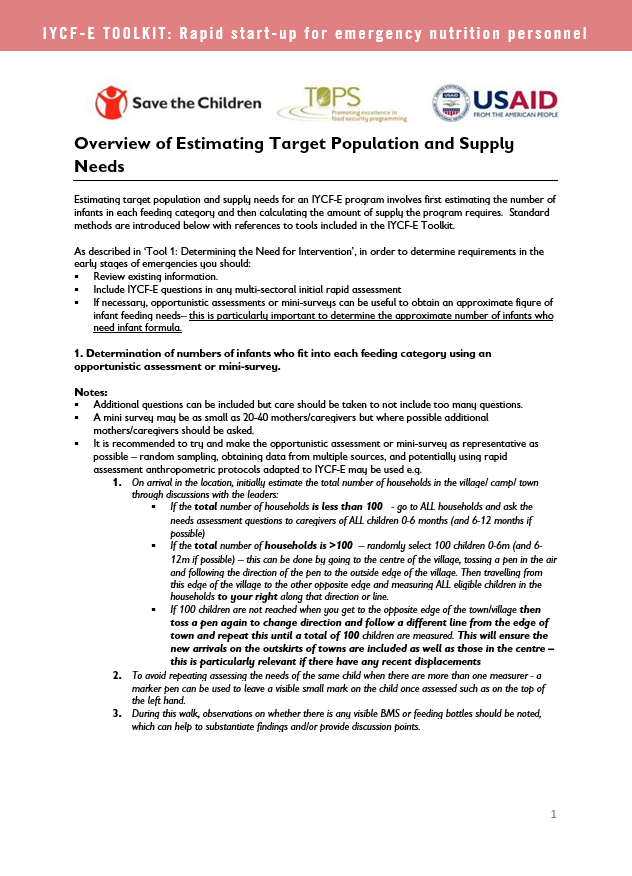
Overview of Estimating Target Population and Supply Needs
A summary of how to estimate target population and calculate supplies needed for each feeding category.
(87.0 KiB)
Section Two: Tools
Mother Baby Area
1 resource
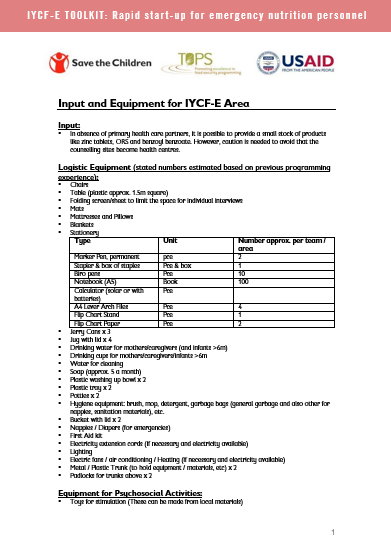
Equipment Needed for Infant and Young Child Feeding in Emergencies (IYCF-E) Area
Equipment and supplies needed for setting up an Infant and Young Child Feeding in Emergencies (IYCF-E) area.
(50.9 KiB)
General Guidance
8 resources
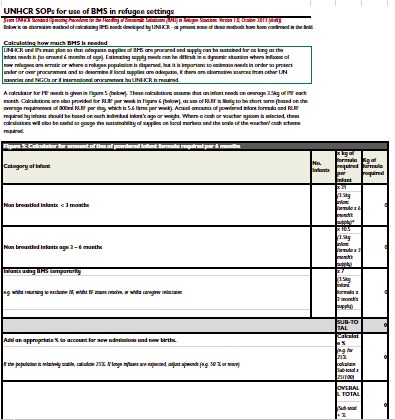
Infant and Young Child Feeding in Emergencies (IYCF-E) Caseload and Supply Calculator
A comprehensive tool to calculate caseload and supplies (Powdered Infant Forlmua/Ready to Use Infant Formula) needed for a Breastmilk substitute (BMS) programme.
(66.2 KiB)
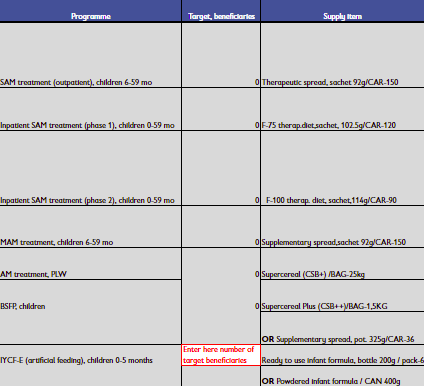
Caseload Target and Supplies Calculator: Global Nutrition Cluster
Template for caseload and supplies calculator by Global Nutrition Cluster.
(104.1 KiB)
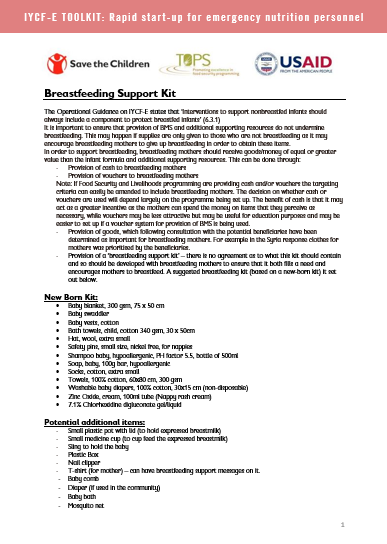
Breastfeeding Support Kit
A list of contents of a breastfeeding support kit.
(49.1 KiB)
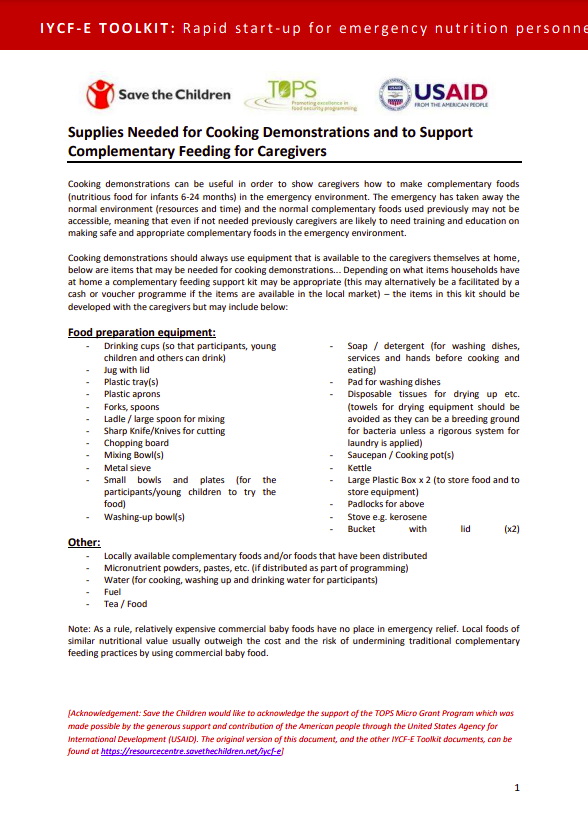
Cooking demo and Complementary Feeding Support Supplies
A list of materials/equipment needed to prepare and conduct a cooking demonstration.
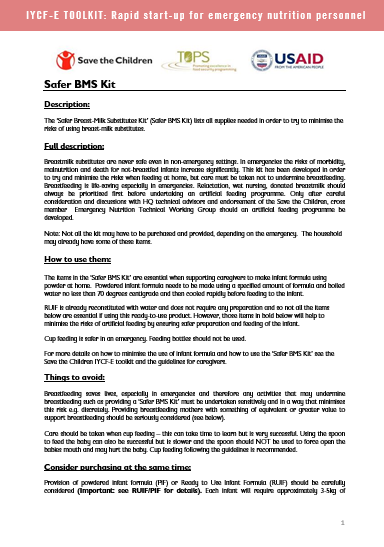
Safer Breastmilk Substitute (BMS) Kit
List of items in a safer Breastmilk substitute (BMS) kit and how to use them.
(66.0 KiB)
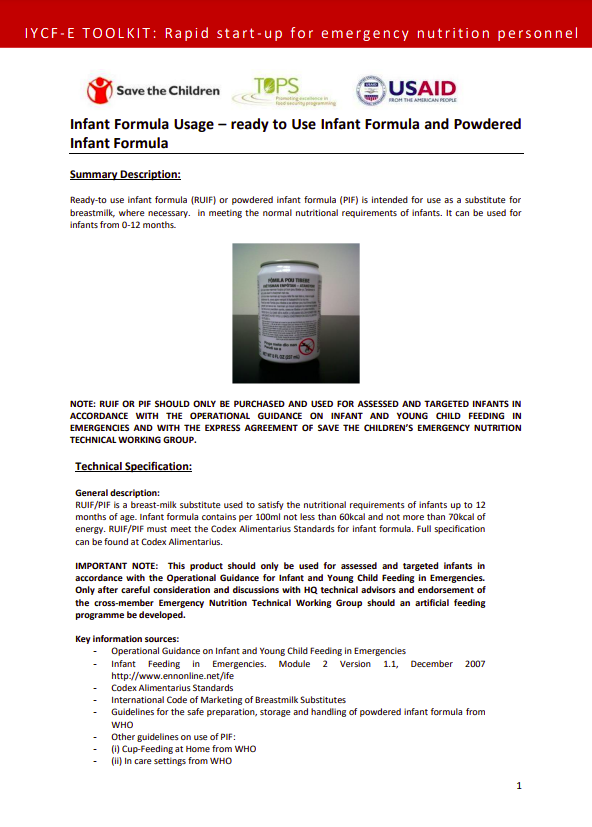
Infant Formula Usage: Ready to Use Infant Formula and Powdered Infant Formula
Information on Ready to Use Infant Formula and Powdered Infant Formula including usage and technical specs.
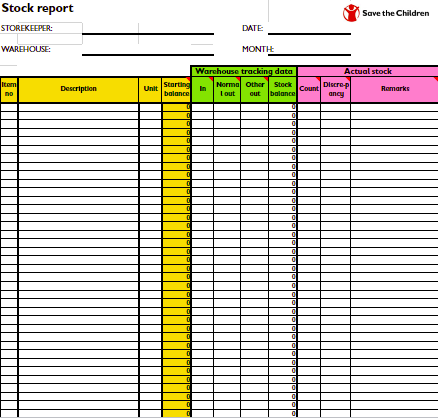
Template for Stock Report
An example of a stock management tool for monitoring and managing available stocks.
(72.0 KiB)
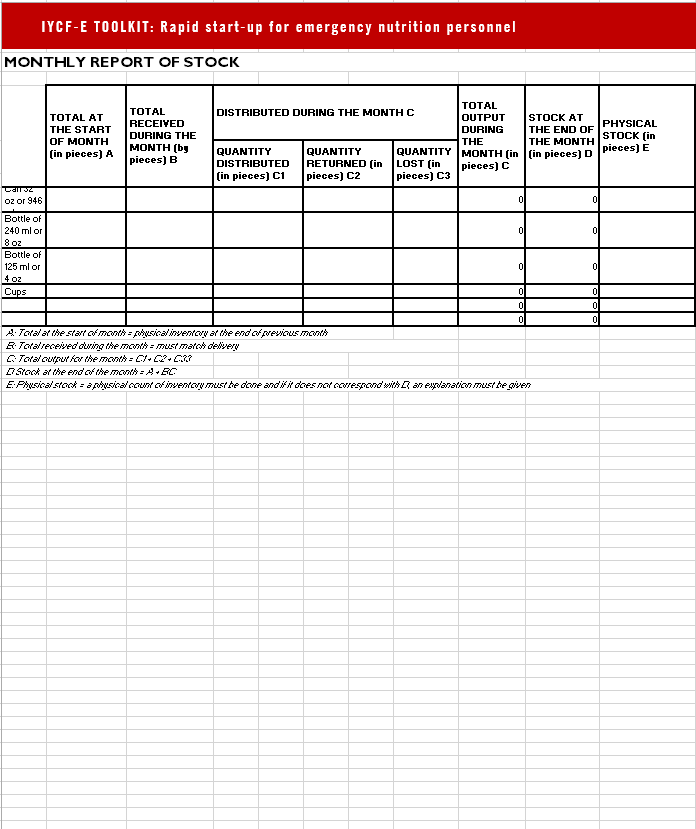
Template for Monthly Stock Report
A compilation of stock records to monitor and manage stock movement monthly.
(35.5 KiB)
References
In the Orientation and Training Collection on the Infant and Young Child Feeding in Emergencies Hub you will find a NiE training package, the Infant and Young Child Feeding Community based package, Community-Based Management of Acute Malnutrition, Infant Feeding in Emergencies and Complementary Feeding training materials.
Chapter 6
6. Staff
Photo: Save the Children Guatemala
Section One: Key Concepts
General Guidance
1 resource
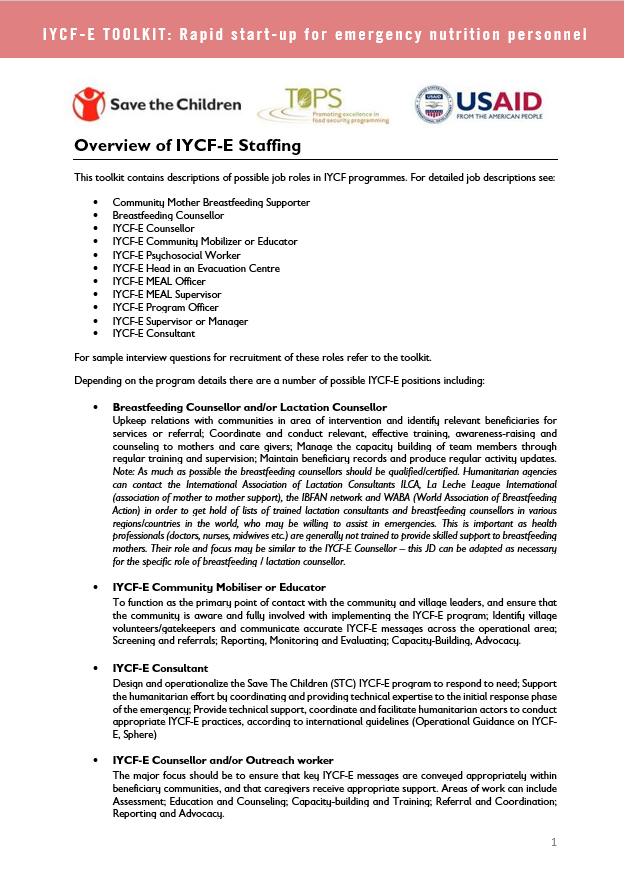
Overview of Infant and Young Child Feeding in Emergencies (IYCF-E) Staffing
Guidance on Infant and Young Child Feeding in Emergencies staffing and descriptions of job roles.
(57.0 KiB)
Section Two: Tools
General Guidance
13 resources
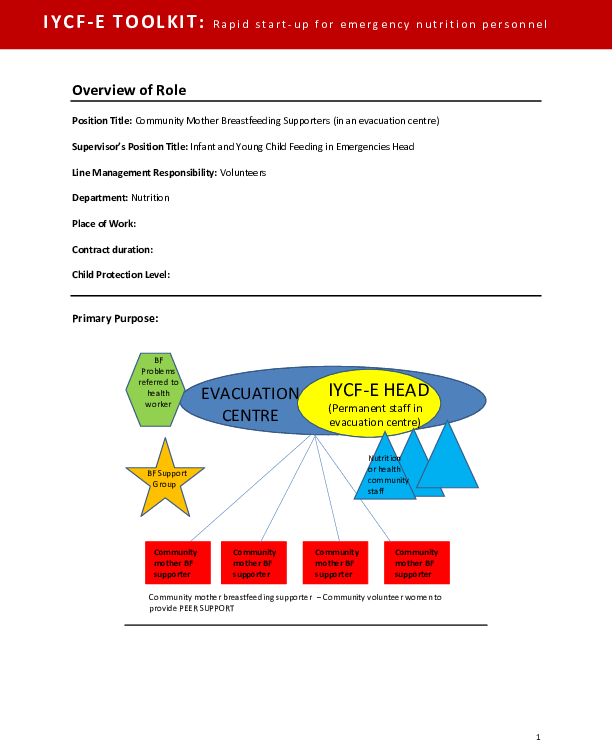
Role of Community Mother Breastfeeding Supporter
An overview of role and responsibility of Mother Breastfeeding Supporters in evacuation centres.
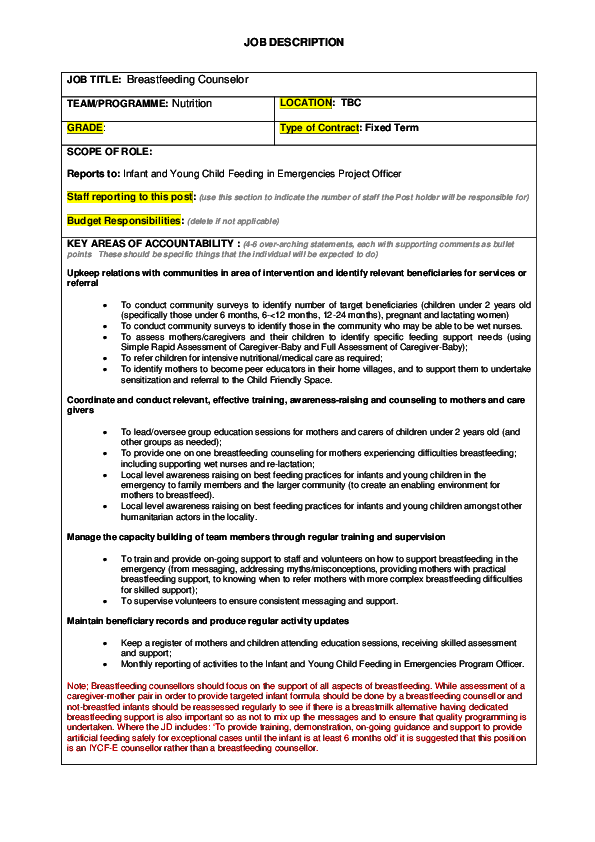
Breastfeeding Counsellor
An example of a job description for a Breastfeeding Counsellor.

Infant and Young Child Feeding in Emergencies Counsellor
An example of a job description for an Infant and Young Child Feeding in Emergencies Counsellor

Infant and Young Child Feeding in Emergencies Community Mobilizer or Educator
An example of a job description for an Infant and Young Child Feeding in Emergencies Community Mobilizer/Educator.
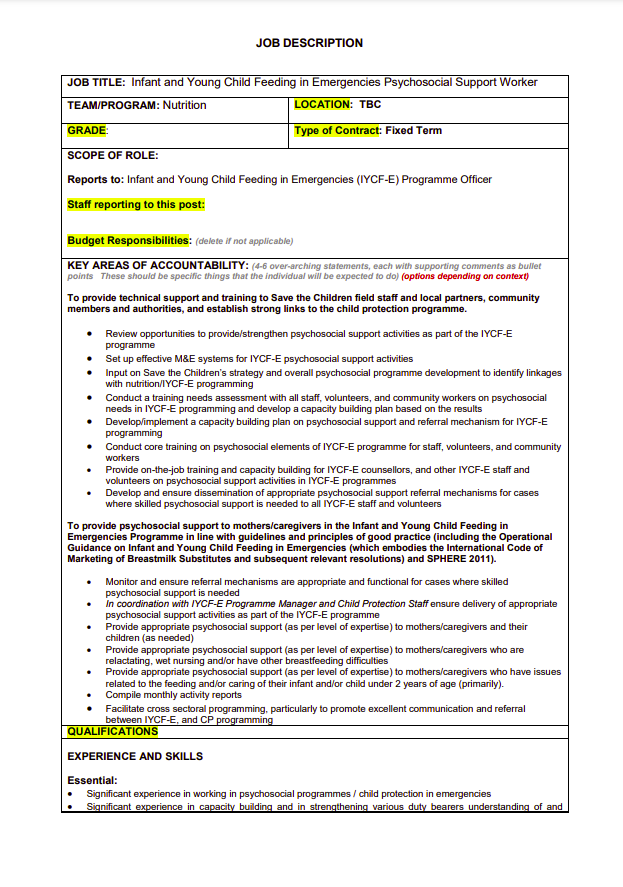
Infant and Young Child Feeding in Emergencies Psychosocial Worker
An example of a job description for an Infant and Young Child Feeding in Emergencies Psychological Worker

Infant and Young Child Feeding in Emergencies Head in an Evacuation Centre
An example of a job description for an Infant and Young Child Feeding in Emergencies Head in an Evacuation Centre.
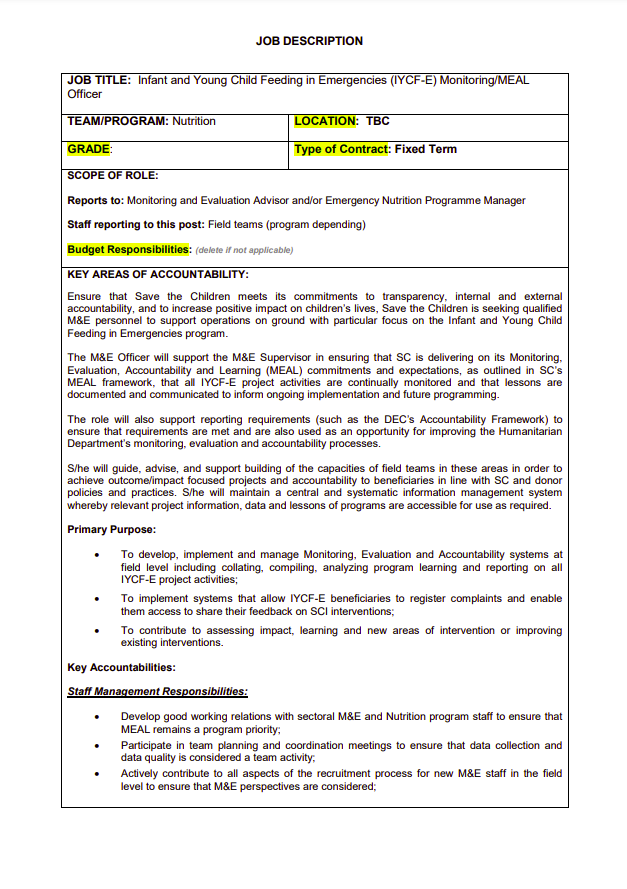
Infant and Young Child Feeding in Emergencies Monitoring, Evaluation, Accountability and Learning Officer
An example of a job description for an Infant and Young Child Feeding in Emergencies Monitoring, Evaluation, Accountability and Learning Officer.

Infant and Young Child Feeding in Emergencies Monitoring, Evaluation, Accountability and Learning Supervisor
An example of a job description for an nfant and Young Child Feeding in Emergencies Monitoring, Evaluation, Accountability and Learning Supervisor.
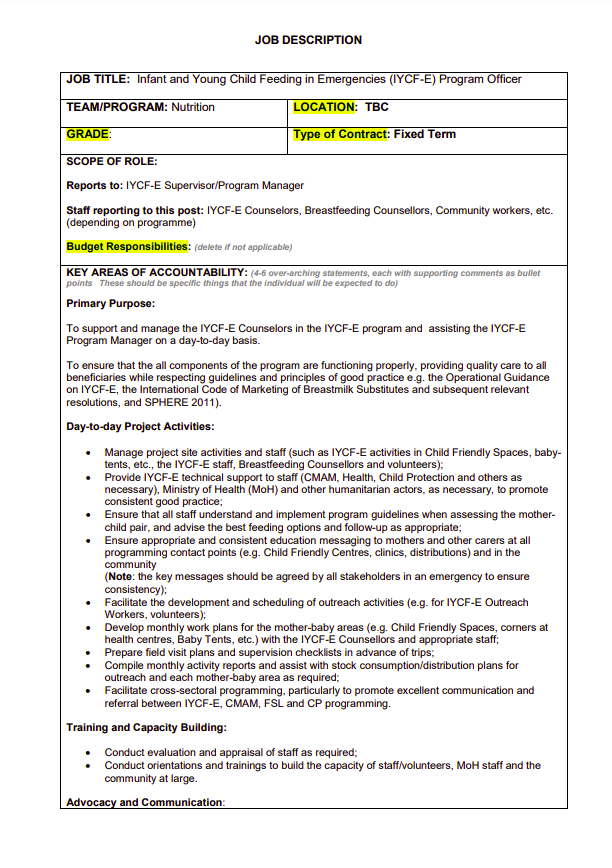
Infant and Young Child Feeding in Emergencies Program Officer
An example of a job description for an Infant and Young Child Feeding in Emergencies Program Officer

Infant and Young Child Feeding in Emergencies Supervisor or Manager
An example of a job description for an Infant and Young Child Feeding in Emergencies Supervisor/Manager.
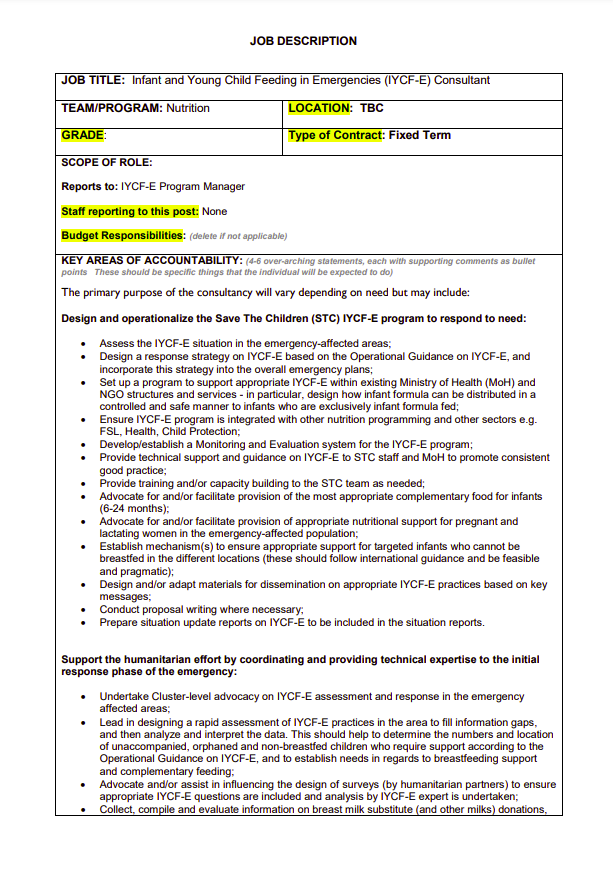
Infant and Young Child Feeding in Emergencies Consultant
An example of a job description for an Infant and Young Child Feeding in Emergencies Consultant
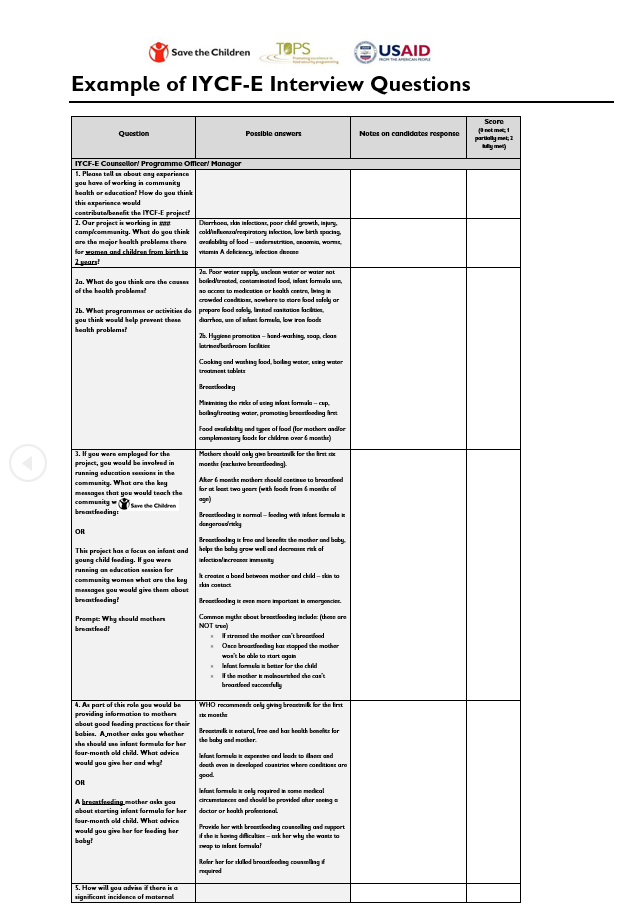
Example of Infant and Young Child Feeding in Emergencies Interview Questions
A sample of interview questions for all levels of Infant and Young Child Feeding in Emergencies personnel.
(126.5 KiB)
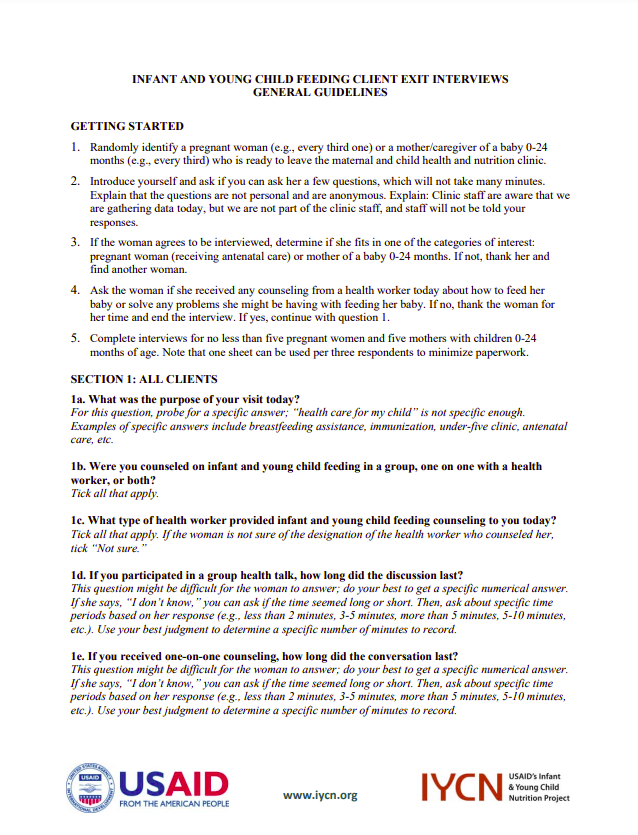
Guidelines for Infant and Young Child Feeding Client Exit Interview
Sample of an exit interview questionnaire and guidelines on conducting an exit interview of a client.
References
In the Staffing Collection on the Infant and Young Child Feeding in Emergencies Hub you will find further resources to support your work.
Chapter 7
7. Orientation and Training
Photo: Jiang Chaocheng - Save the Children
Section One: Key Concepts
General Guidance
1 resource

Overview of Infant and Young Child Feeding in Emergencies Module 1 v2.1 2010
Summarized package of Infant and Young Child Feeding in Emergencies (IYCF-E) resources to help in orientation and training of IYCF-E technical staff involved in planning and responding to emergencies, at national and international level.
(75.5 KiB)
Section Two: Tools
General Guidance
19 resources
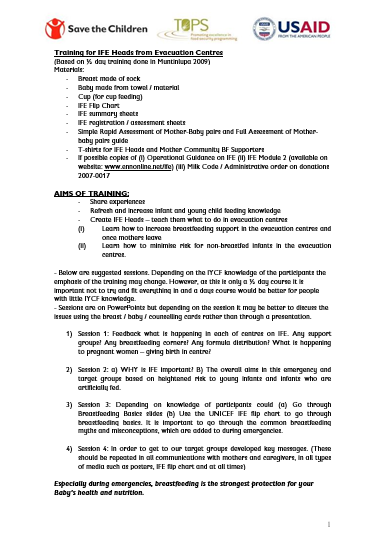
Training Plan for Infant Feeding in Emergencies (IFE) Heads from Evacuation Centres
A basic seven session training plan for Infant Feeding in Emergencies heads from evacuation centres.
(57.0 KiB)
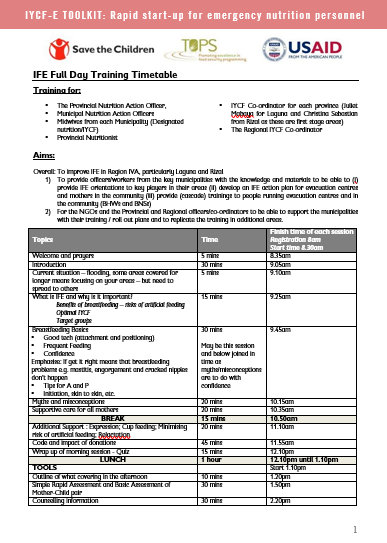
Infant Feeding in Emergencies Full Day Training Timetable
Timetable for a one-day training on Infant Feeding in Emergencies for field level workers.
(72.5 KiB)
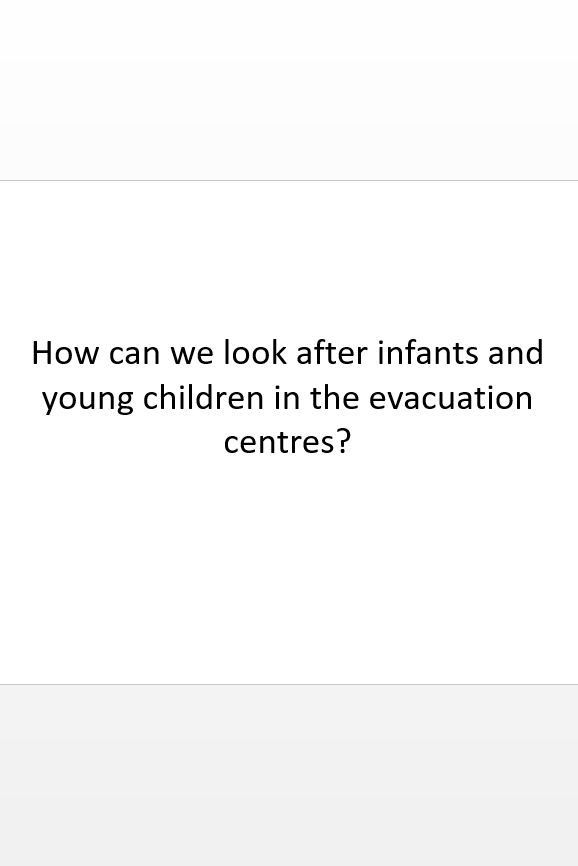
Infant Feeding in Emergencies in Evacuation Centres
Brief illustration of how Infant Feeding in Emergencies can be supported in evacuation centres.
(167.5 KiB)

Why is Infant Feeding in Emergencies important
Recognizing and understanding the significance of Infant Feeding in Emergencies, what risks are involved and how support can be provided.
(3.9 MiB)
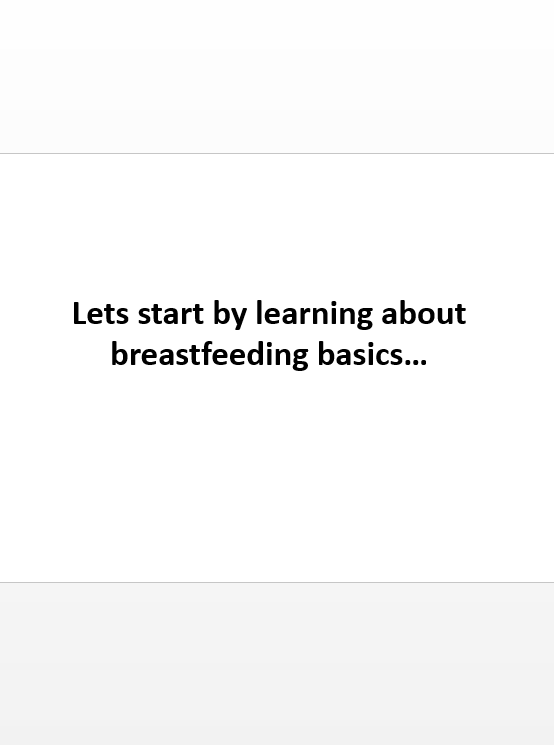
Breastfeeding Basics
Familiarization on proper attachment and positioning during breastfeeding, increasing milk flow, maintaining skin-to-skin contact and encouraging mothers.
(2.6 MiB)
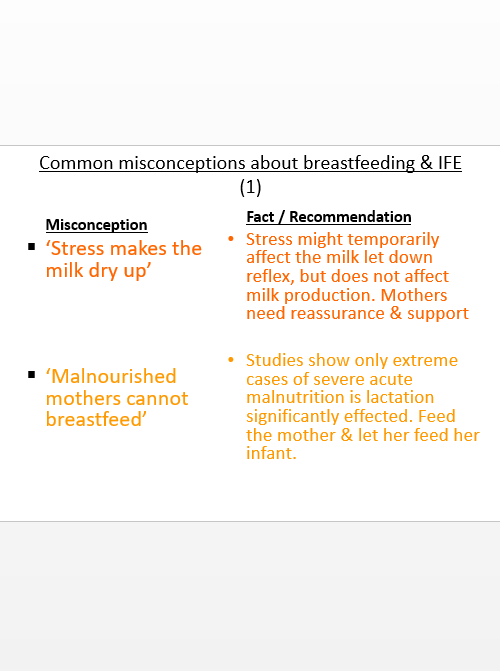
Myths and Misconceptions
Common myths and misconceptions about Infant Feeding in Emergencies explained by providing facts and recommendations.
(163.0 KiB)
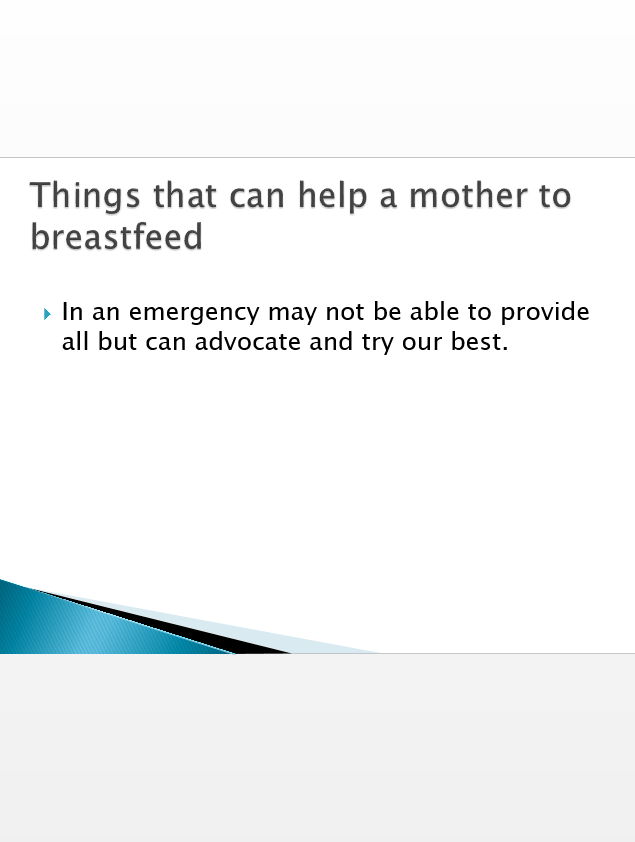
Infant Feeding in Emergencies Supportive Care
Elements of supportive care that can help a mother to breastfeed.
(2.1 MiB)
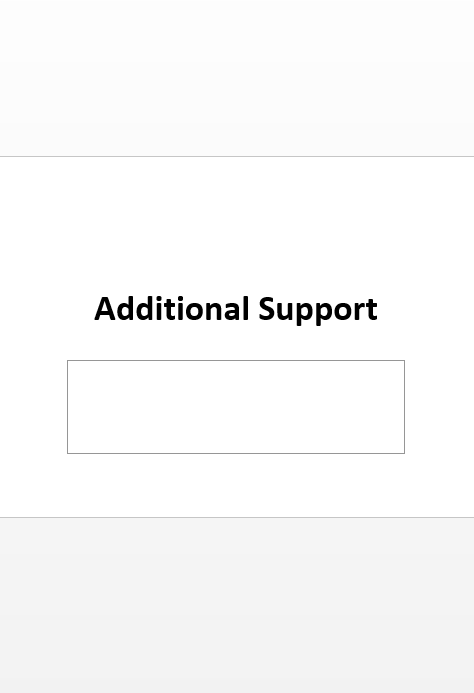
Additional Support
Additional material about cup feeding, breastmilk expression, artificial feeding, relactation, Kangaroo care and other ways of feeding an infant.
(2.8 MiB)
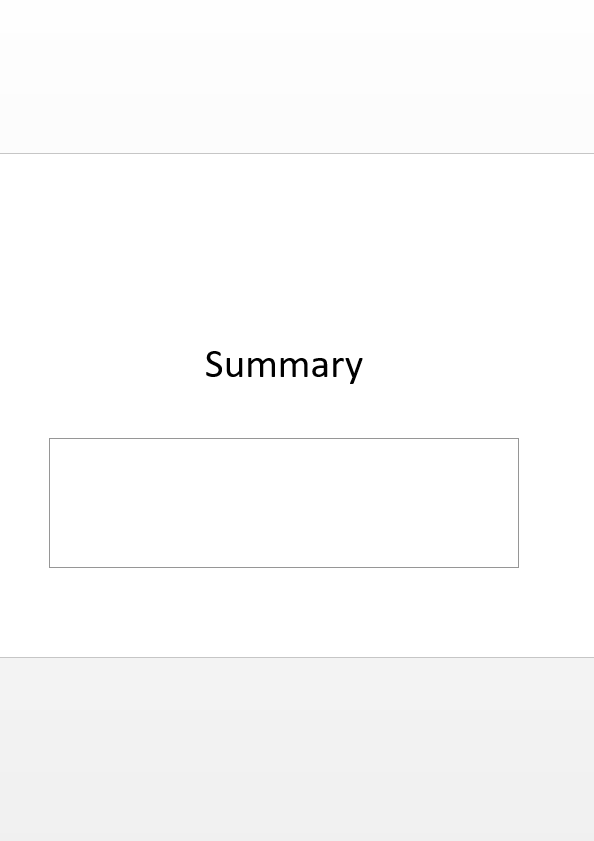
Summary of Good Breastfeeding: End of Morning Session
Summary of points for assessing a good breastfeeding session and techniques that can be applied for improving it.
(161.0 KiB)
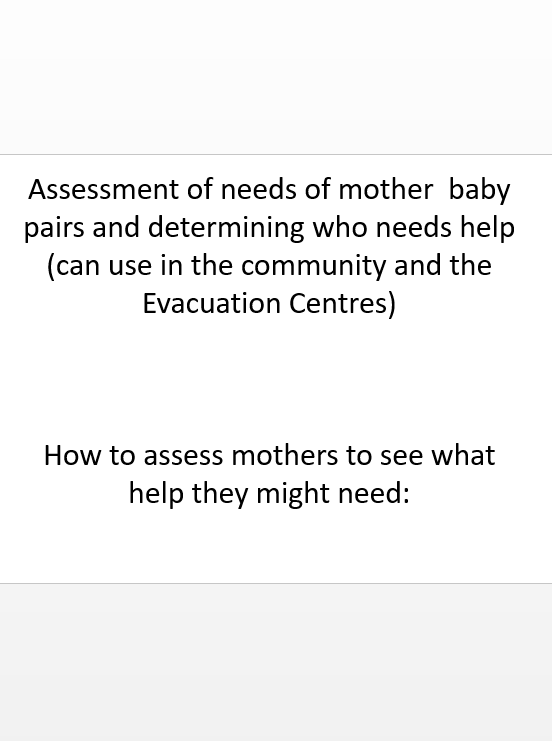
Simple Rapid Assessment
A framework with possible questions to ask while assessing a mother/child pair for Infant and Young Child Feeding practices
(623.0 KiB)

Counselling Skills
How to conduct counselling while applying listening and learning skills and conduct a home visit for follow-up.
(526.0 KiB)
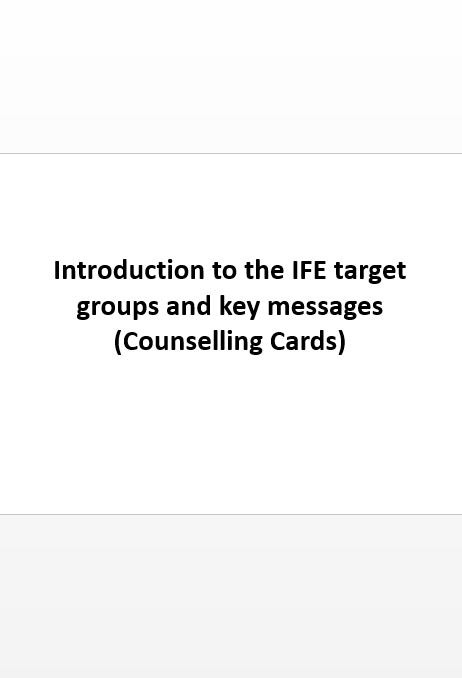
Counselling Cards
Counselling cards illustrating key messages based on different target groups.
(233.5 KiB)

Key Infant Feeding in Emergencies Messages
Key messages on breastfeeding post-emergency.
(134.0 KiB)
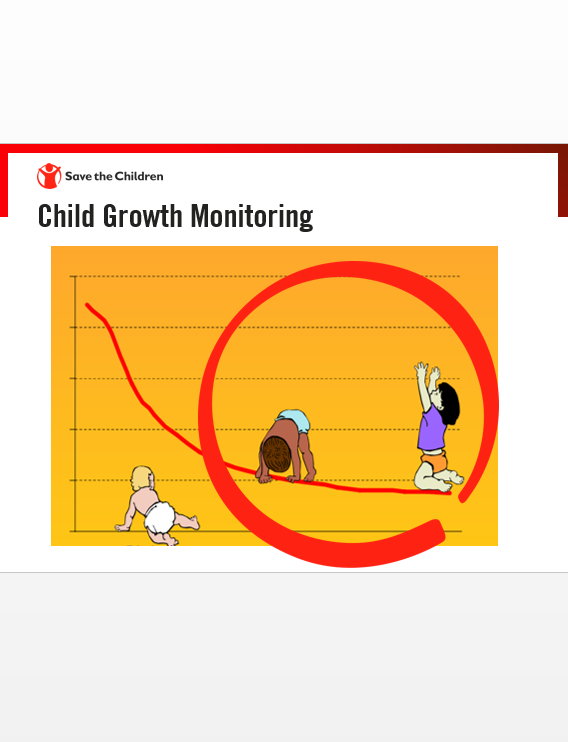
Child Growth Monitoring Training Save the Children Greece 2016
A presentation on growth monitoring including how to take different anthropometric measurements.
(3.7 MiB)

Scenario 1: Participants
A case study for Infant Feeding in Emergencies with related questions.
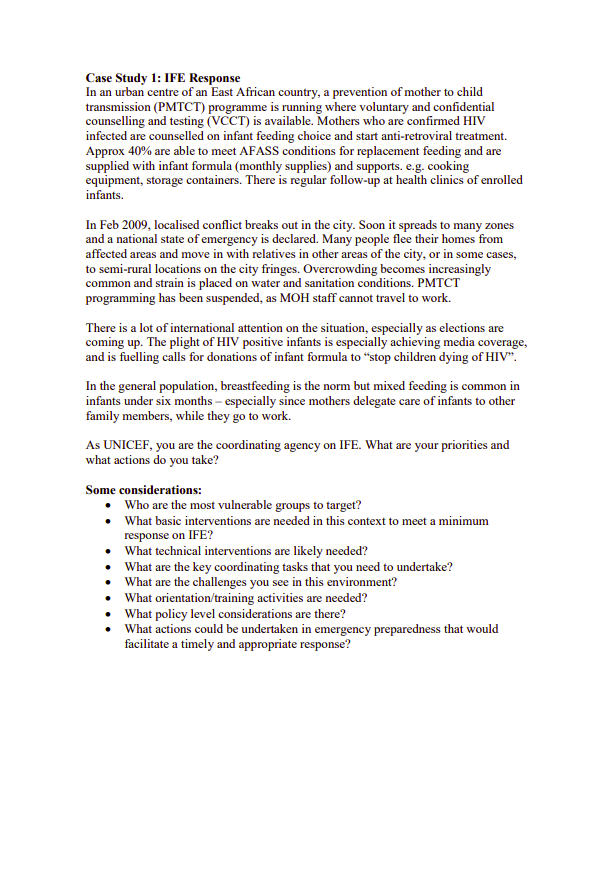
Scenario 1b: Answer sheet
The answers to the questions posed in the case study.

Donations Breastmilk Substitute and Other Milks in Emergencies
A presentation on examples of Breastmilk Substitute and infant formula donations in emergencies and suggesting ways to deal with such donations.
(3.3 MiB)

Integration of Infant and Young Child Feeding Support into Community-Based Management of Acute Malnutrition: Handouts
An easy reference to information on Infant and Young Child Feeding integration with Community-Based Management of Acute Malnutrition in the form of hand-outs.
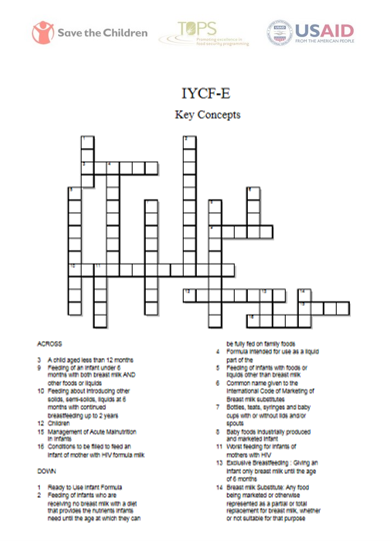
Crossword
A crossword on Infant and Young Child Feeding.
(487.2 KiB)
References
In the Orientation and Training Collection on the Infant and Young Child Feeding in Emergencies Hub you will find further resources to support your work.
Chapter 8
8. Programme Monitoring and Supervision
Photo: Nadège Mazars - Save the Children
Section One: Key Concepts
General Guidance
1 resource
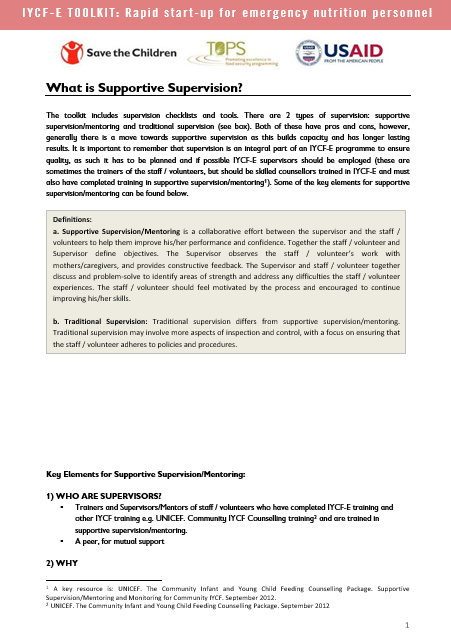
Summary of Supportive Supervision
Summary of the key elements of supportive supervision.
(80.0 KiB)
Section Two: Tools
General Guidance
8 resources
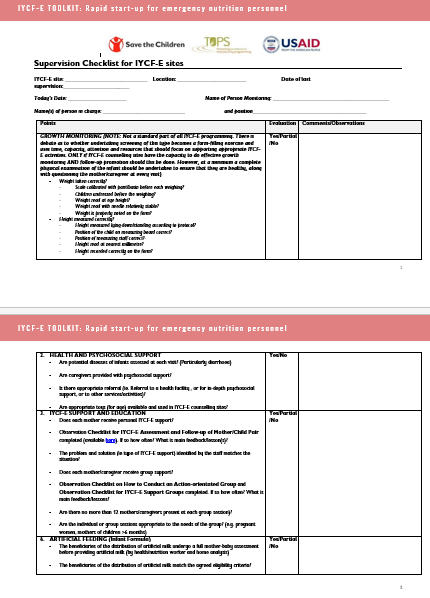
Template for Supervision Checklist for Infant and Young Child Feeding in Emergencies Centres
An example of a supervision checklist for Infant and Young Child Feeding in Emergencies centres.
(55.4 KiB)
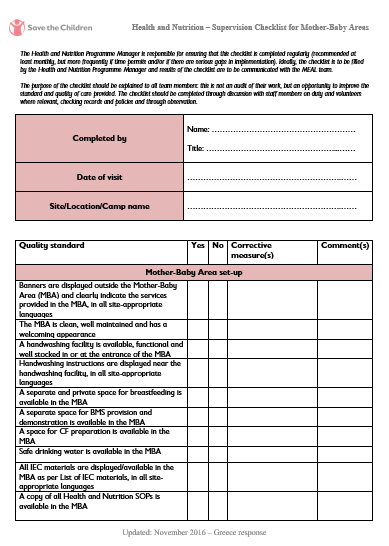
Example of Supervision Checklist for Mother-Baby Areas: Save the Children Greece 2016
An example of supervision checklist for Mother-Baby Areas used by Save the Children in Greece.
(31.5 KiB)
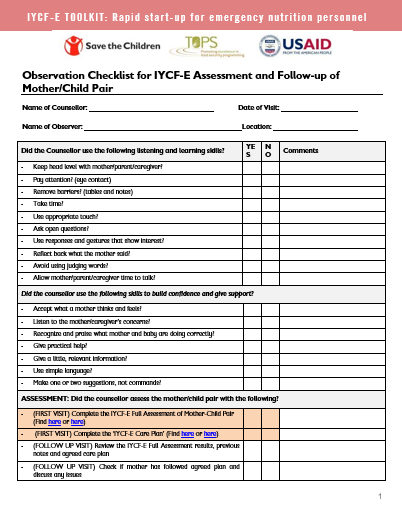
Template for Observation Checklist for Infant and Young Child Feeding in Emergencies Assessment of Mother
An example of an observation checklist to evaluate how an Infant and Young Child Feeding in Emergencies assessment of a mother should be conducted.
(53.0 KiB)

Template for Observation Checklist for Infant and Young Child Feeding in Emergencies Support Group
An example of an observation checklist to evaluate an Infant and Young Child Feeding in Emergencies support group session.
(50.2 KiB)
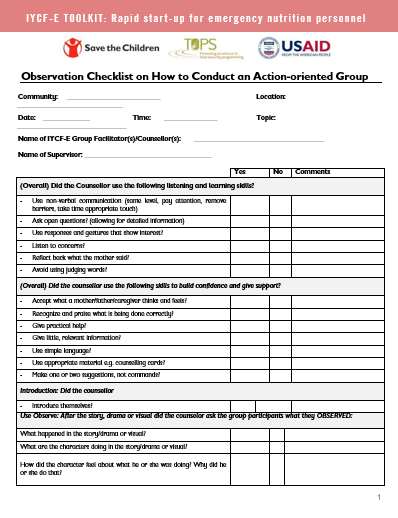
Template for Observation Checklist for Action Orientated Group
An example of an observation checklist to evaluate an action-oriented group session.
(51.6 KiB)
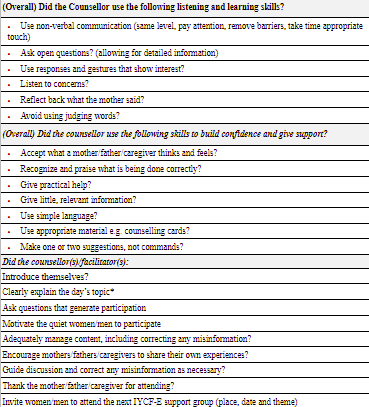
Template for Supervision Checklists in Excel
An example of a supervision checklist for an Infant and Young Child Feeding in Emergencies mother-baby assessment.
(78.8 KiB)
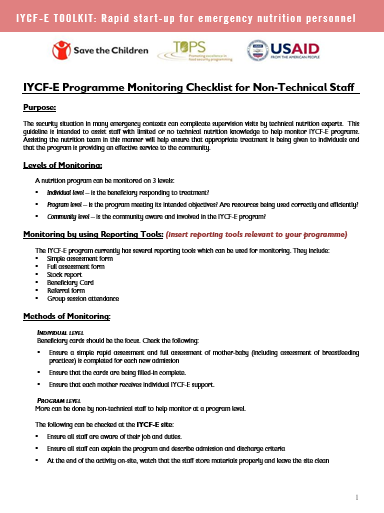
Template for Infant and Young Child Feeding in Emergencies Monitoring Checklist for Non-Technical Staff
An Infant and Young Child Feeding in Emergencies program monitoring checklist for non-technical staff.
(69.5 KiB)

Template for Infant and Young Child Feeding in Emergencies Field Report
A template for the structure of an Infant and Young Child Feeding in Emergencies field report.
Chapter 9
9. Coordination and Communications
Photo: Jiang Chaocheng - Save the Children
Section One: Key Concepts
General guidance
1 resource
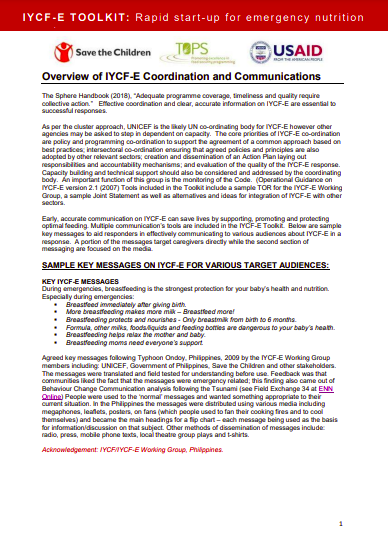
Overview of Infant and Young Child Feeding in Emergencies Coordination and Communications
A set of sample key messages on Infant and Young Child Feeding in Emergencies (IYCF-E) for different target audiences, suggested media spots and examples of relevant IYCF-E tweets.
Section Two: Tools
Coordination
6 resources
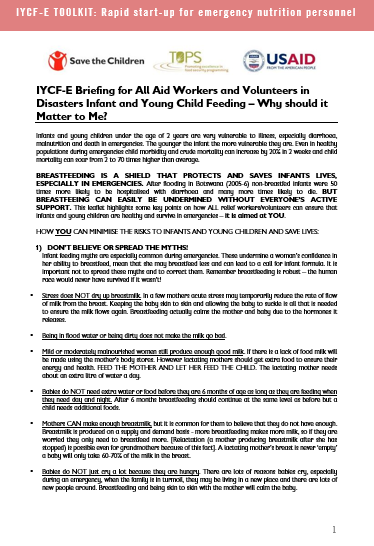
Infant and Young Child Feeding in Emergencies Briefing for All Aid Workers and Sectors
A guideline summarizing how all volunteers and staff can help support Infant and Young Child Feeding in Emergencies.
(53.2 KiB)
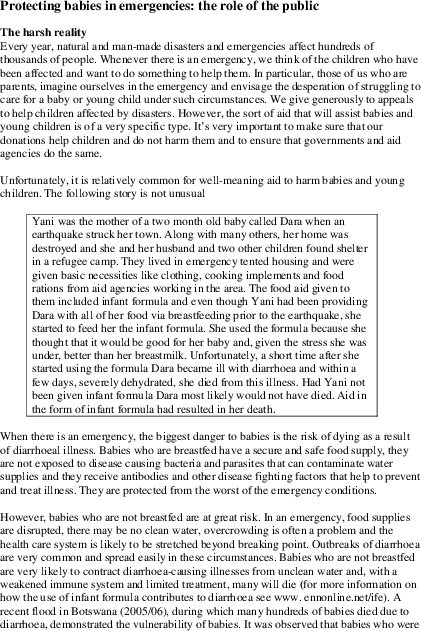
Infant and Young Child Feeding in Emergencies Guide for the Public to Support Ops Guidance: IFE Core Group 2007
A guideline of how the public can support Infant and Young Child Feeding in Emergencies.
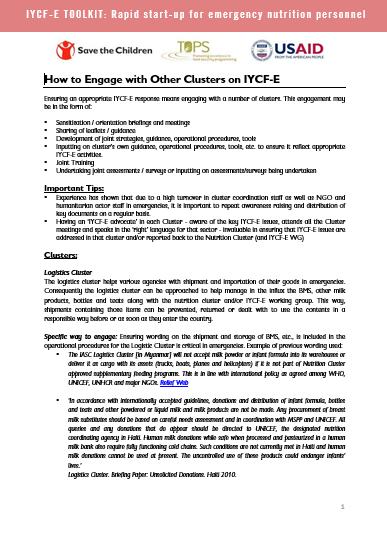
How to Engage with Other Clusters on Infant and Young Child Feeding in Emergencies
Tips on how to engage with other clusters to coordinate an Infant and Young Child Feeding in Emergencies response.
(62.0 KiB)

Infant and Young Child Feeding in Emergencies Integration with other Sectors Matrix: Philippines 2013
An example matrix from an emergency response in the Philippines for Infant and Young Child Feeding in Emergencies specific nutrition interventions integrated with other sectors.
(79.0 KiB)
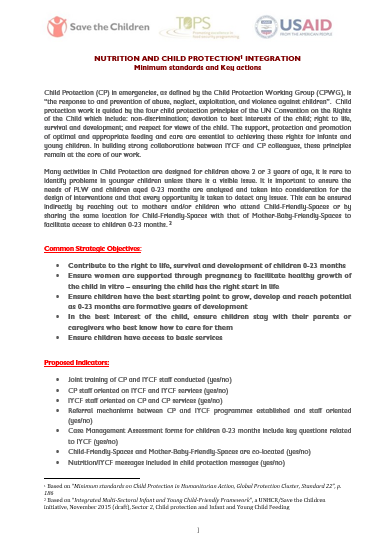
Example of Child Protection and Nutrition Integration: Greece
Example from Greece about Integration with child protection including indicators and key actions.
(46.4 KiB)
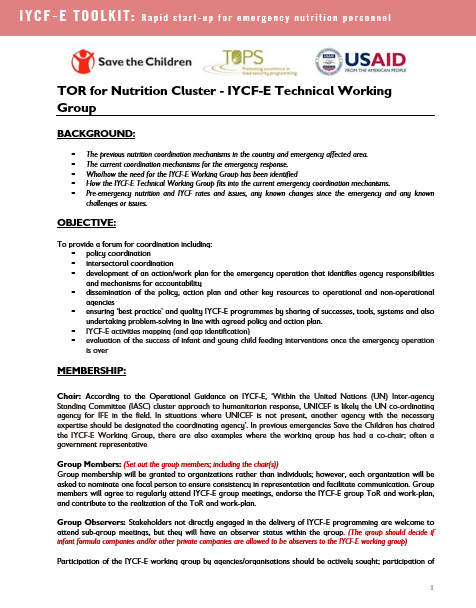
Template for Infant and Young Child Feeding in Emergencies Working Group Terms of Reference
A draft of terms of reference for an Infant and Young Child Feeding in Emergenciesworking group.
(46.2 KiB)
Joint Statement
4 resources

Template for Joint Statement on Infant and Young Child Feeding in Emergencies 2008
A template for Infant and Young Child Feeding in Emergencies joint statement.
(69.0 KiB)
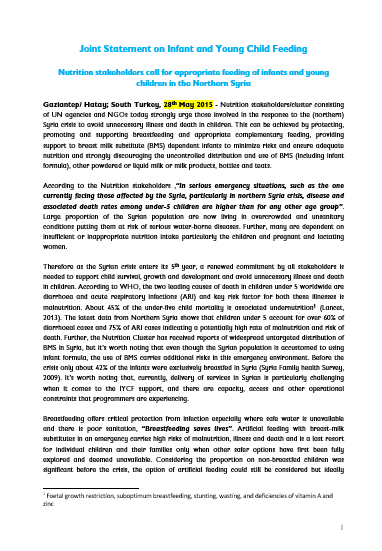
Example of Infant and Young Child Feeding Joint Statement: Syria
Example of the most recent Infant and Young Child Feeding joint statement used in Ukraine
(39.8 KiB)

Example of Infant and Young Child Feeding Emergencies statement: Haiti 2010
Example of Infant and Young Child Feeding Emergencies statement used in Haiti.
(99.5 KiB)
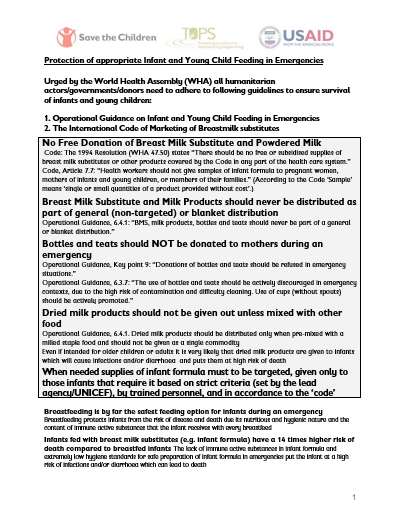
Example of Infant and Young Child Feeding in Emergencies Briefing: Pakistan 2010
Example of an Infant and Young Child Feeding in Emergencies briefing from Pakistan, which highlights key messages with relevant references.
(39.0 KiB)
Media
6 resources
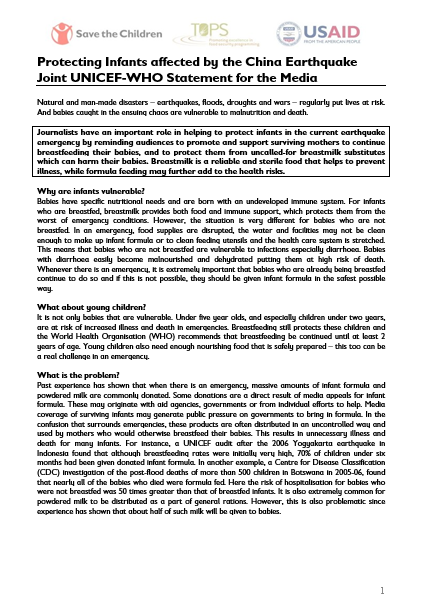
Media Statement on Infant Feeding in Emergencies: UNICEF China
Joint statement from UNICEF and WHO for the media on protecting infants affected by the earthquake in China by encouraging surviving mothers to continue breastfeeding their babies and protecting them from unrequested breastmilk substitutes.
(52.5 KiB)
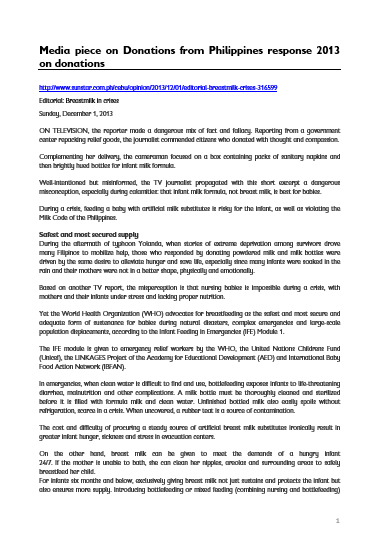
Press Release: Accounting for Non-Breastfed infants and Babies: Phillipines 2013
An example of a press release from the Philippines accounting for the needs of non-breastfed infants.
(36.5 KiB)
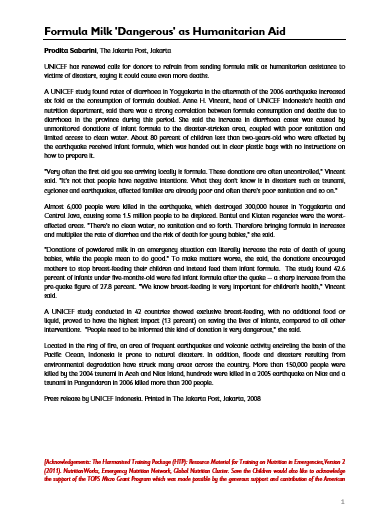
Press Release: Formula milk 'dangerous' as humanitarian aid: Indonesia 2006
An example of a press release from Indonesia related to Breastmilk Substitute donations.
(33.0 KiB)
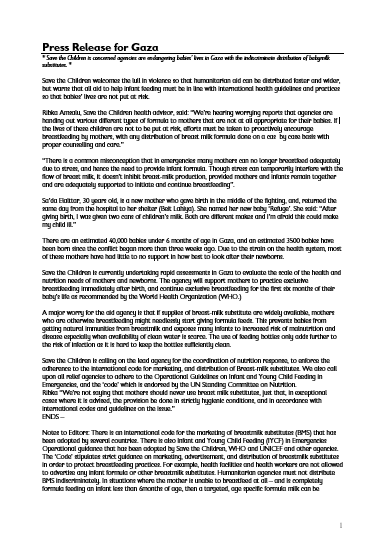
Press Release Gaza 2009
An example of a press release from Gaza related to Breastmilk Substitute donations.
(35.5 KiB)
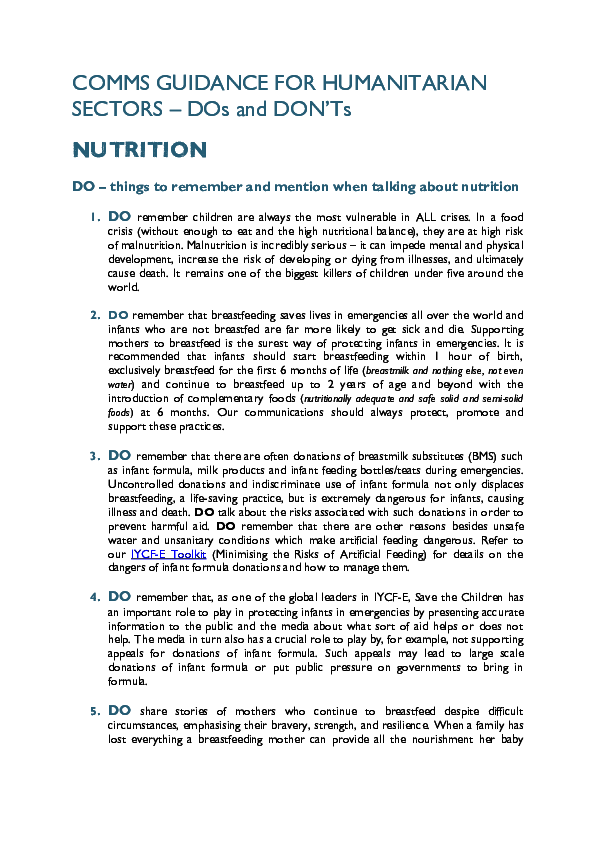
Communications Guidance for Humanitarian Sectors: Save the Children 2016
The Dos and Don’ts of communication about Infant and Young Child Feeding in Emergencies by Save the Children.
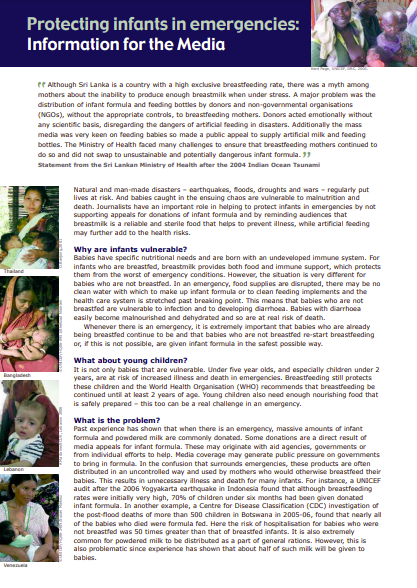
Infant and Young Child Feeding in Emergencies Media Guide: IASC
A two-page brief for the media providing information about Infant and Young Child Feeding in Emergencies and how media can help.
Communication with Mothers
2 resources
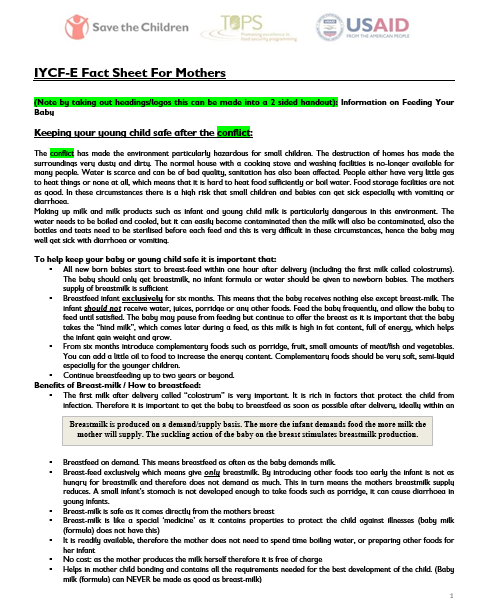
Example of Infant and Young Child Feeding in Emergencies: Fact Sheet for Mothers: Lebanon
An example leaflet for mothers on how to protect their children by knowing the benefits of appropriate breastfeeding and complementary feeding and knowing the risks of artificial feeding.
(191.0 KiB)
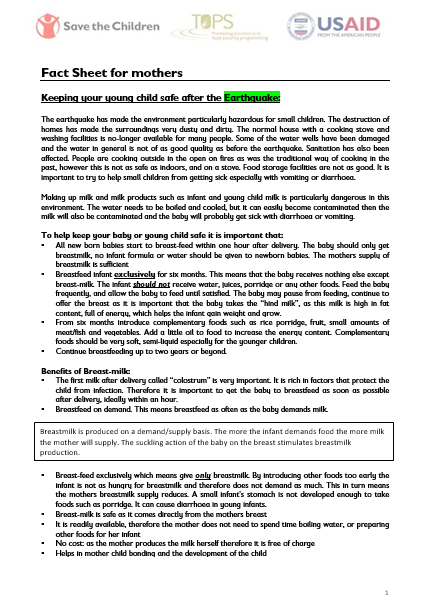
Example of Infant and Young Child Feeding in Emergencies: Fact Sheet for Mothers: Indonesia
An example leaflet for mothers on how to protect their children by knowing the benefits of appropriate breastfeeding and complementary feeding.
(55.0 KiB)
Communication with Health Workers
6 resources
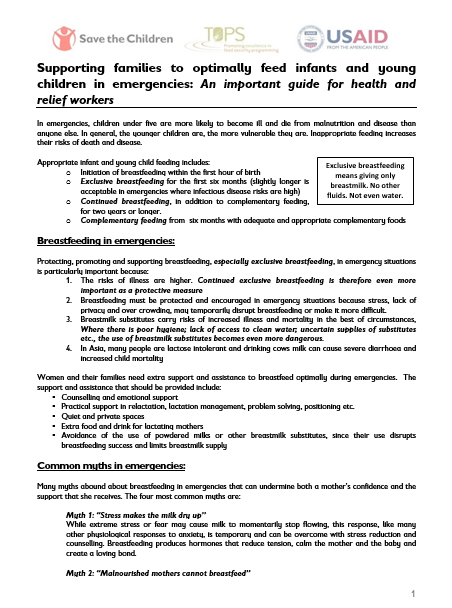
Example Leaflet for Health workers
A leaflet for health workers on how to support caregivers on breastfeeding and complementary feeding in emergencies and how to deal with Breastmilk Substitute donations.
(74.5 KiB)
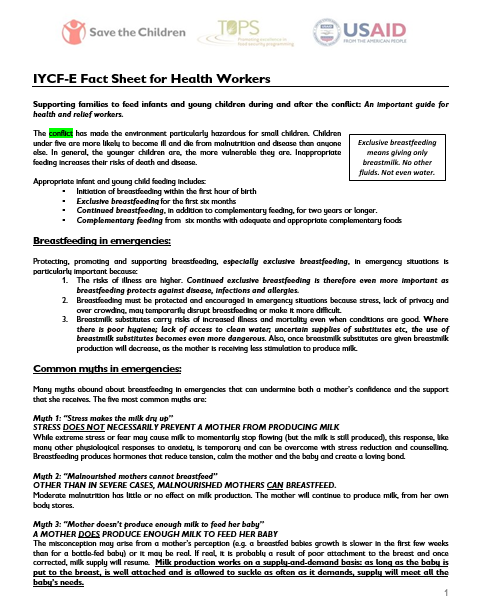
Example of Infant and Young Child Feeding in Emergencies Fact Sheet for Health Workers
A concise guideline for health workers on how to support caregivers on breastfeeding and complementary feeding in emergencies.
(287.0 KiB)
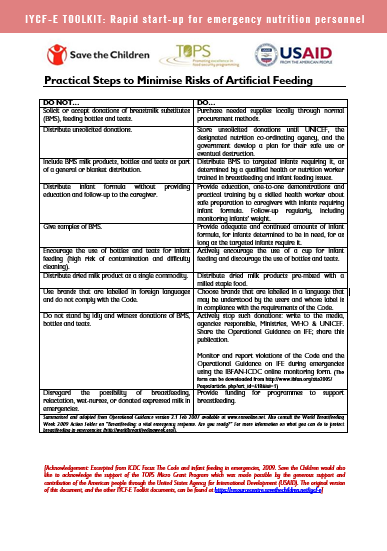
Dos and Don'ts: Practical Steps to Minimise Artificial Feeding in Emergencies: ICDC 2009
The Dos and Don’ts of minimizing artificial feeding in emergencies by ICDC.
(61.0 KiB)
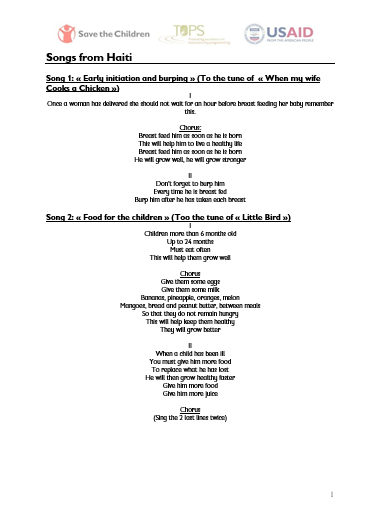
Infant Feeding Songs: Haiti 2010
Songs from Haiti on infant feeding and hand washing.
(51.5 KiB)
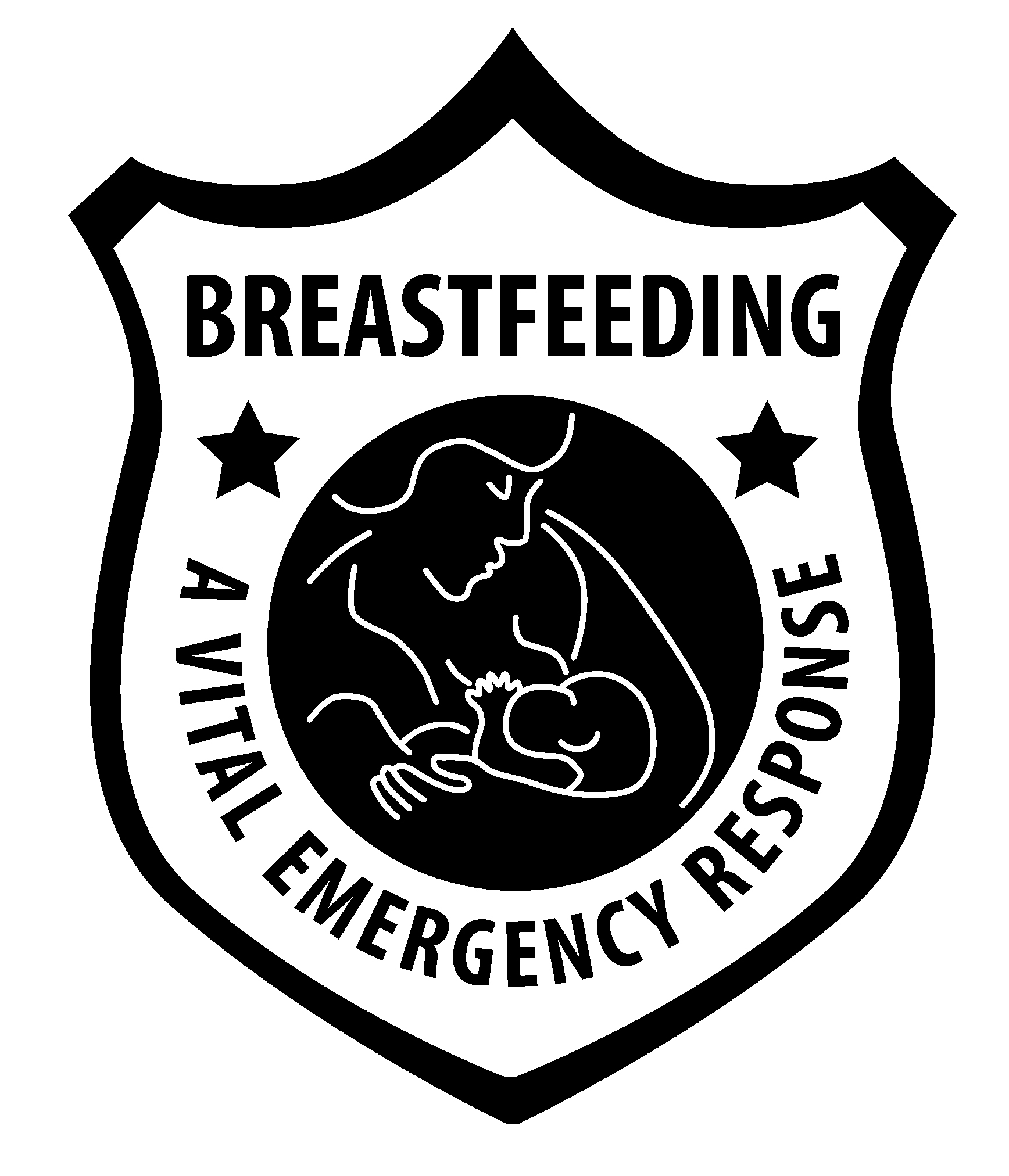
Breastfeeding Badge: A Vital Emergency Response
A sample badge illustrating breastfeeding as a vital emergency response.
(476.8 KiB)
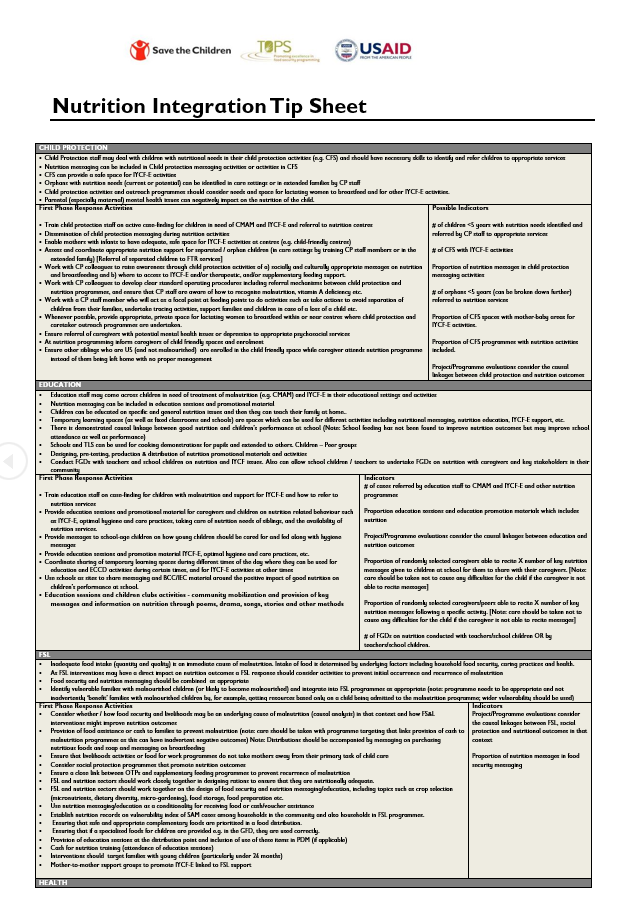
Nutrition Integration Tip Sheet 2013
Tips on how to integrate Infant and Young Child Feeding in Emergencies with other clusters through different activities including which indicators to use.
(58.2 KiB)
References
In the Coordination and Communications Collection on the Infant and Young Child Feeding in Emergencies Hub you will find further resources to support your work.
Suggested citation: Save the Children. Infant and Young Child Feeding in Emergencies Toolkit. 2022.

